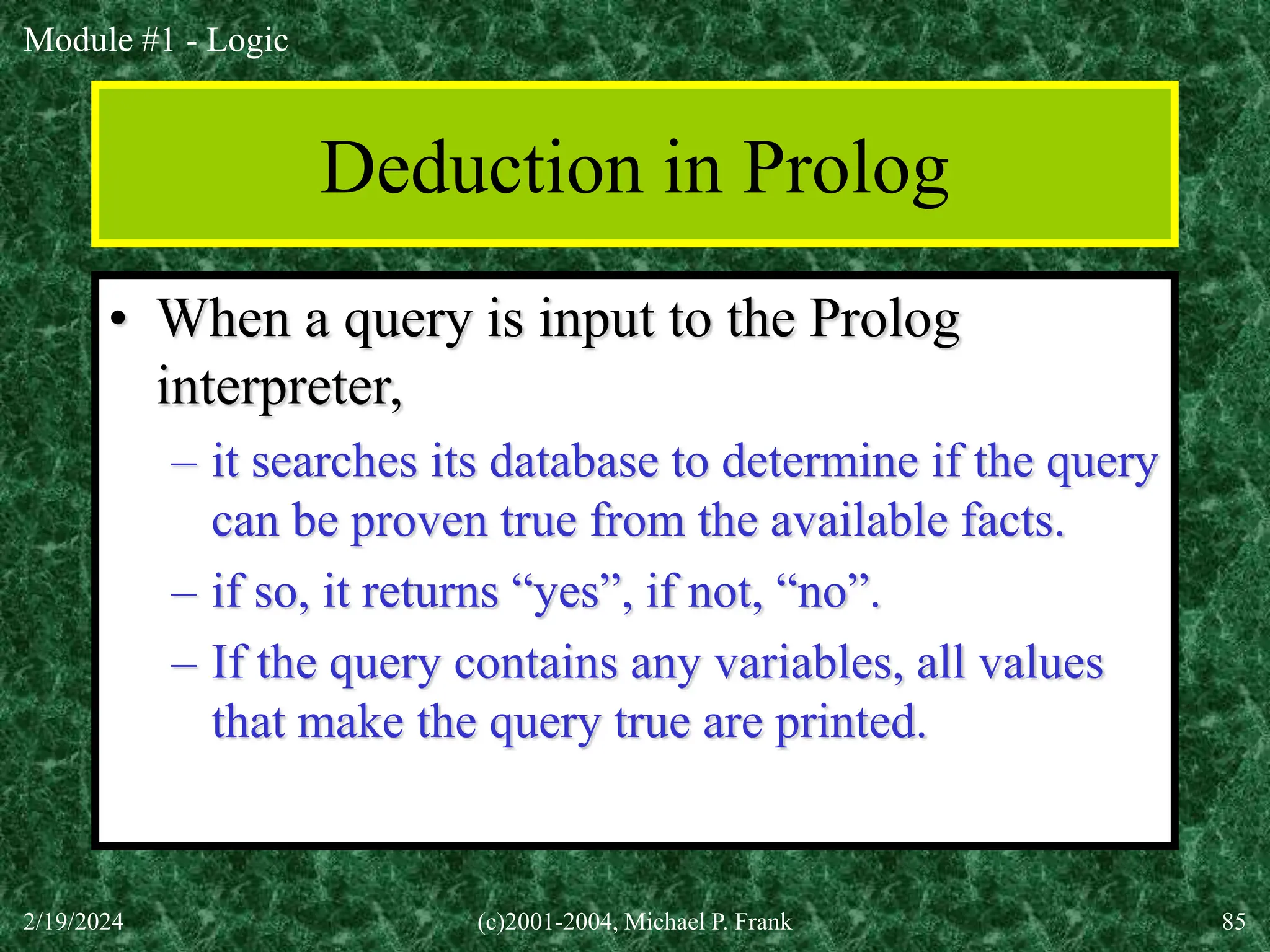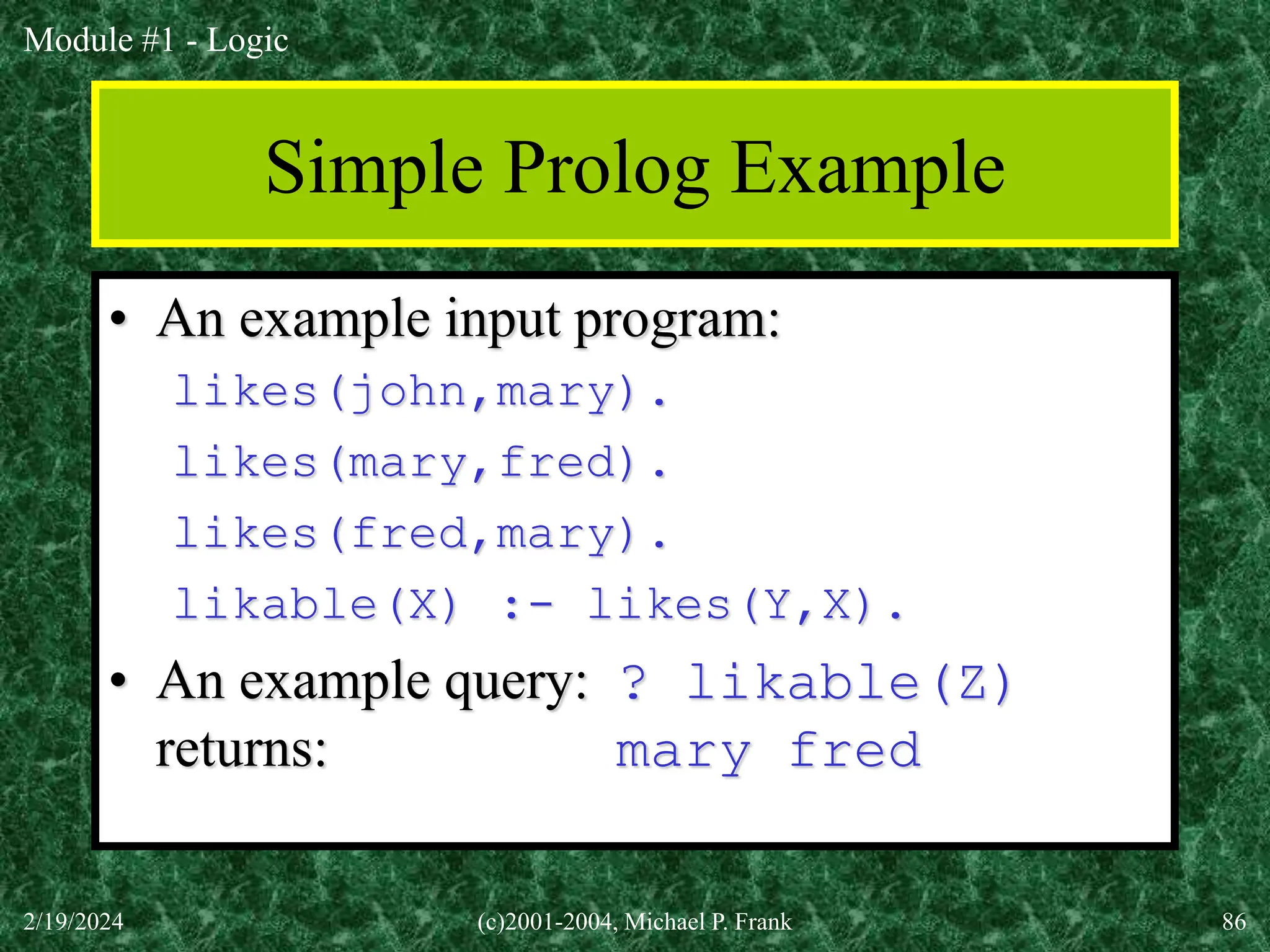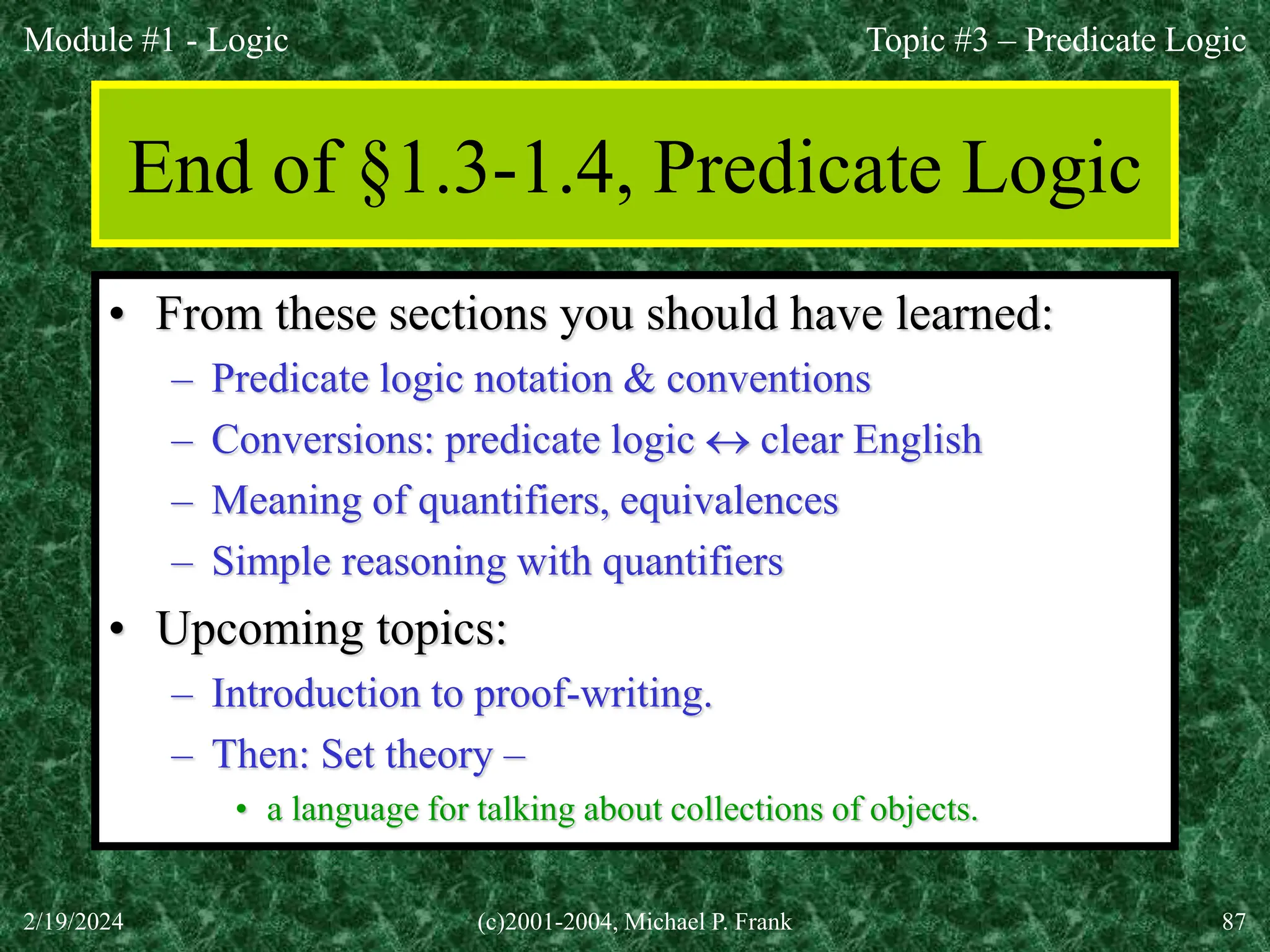This document provides an overview of Module 1 of a logic course. It covers propositional logic, including definitions of basic concepts like propositions and logical operators. It explains propositional operators like negation, conjunction, disjunction, implication and biconditional. Truth tables are provided to illustrate the meaning and evaluation of expressions using these operators. The module will cover both propositional and predicate logic over its lectures and slides.
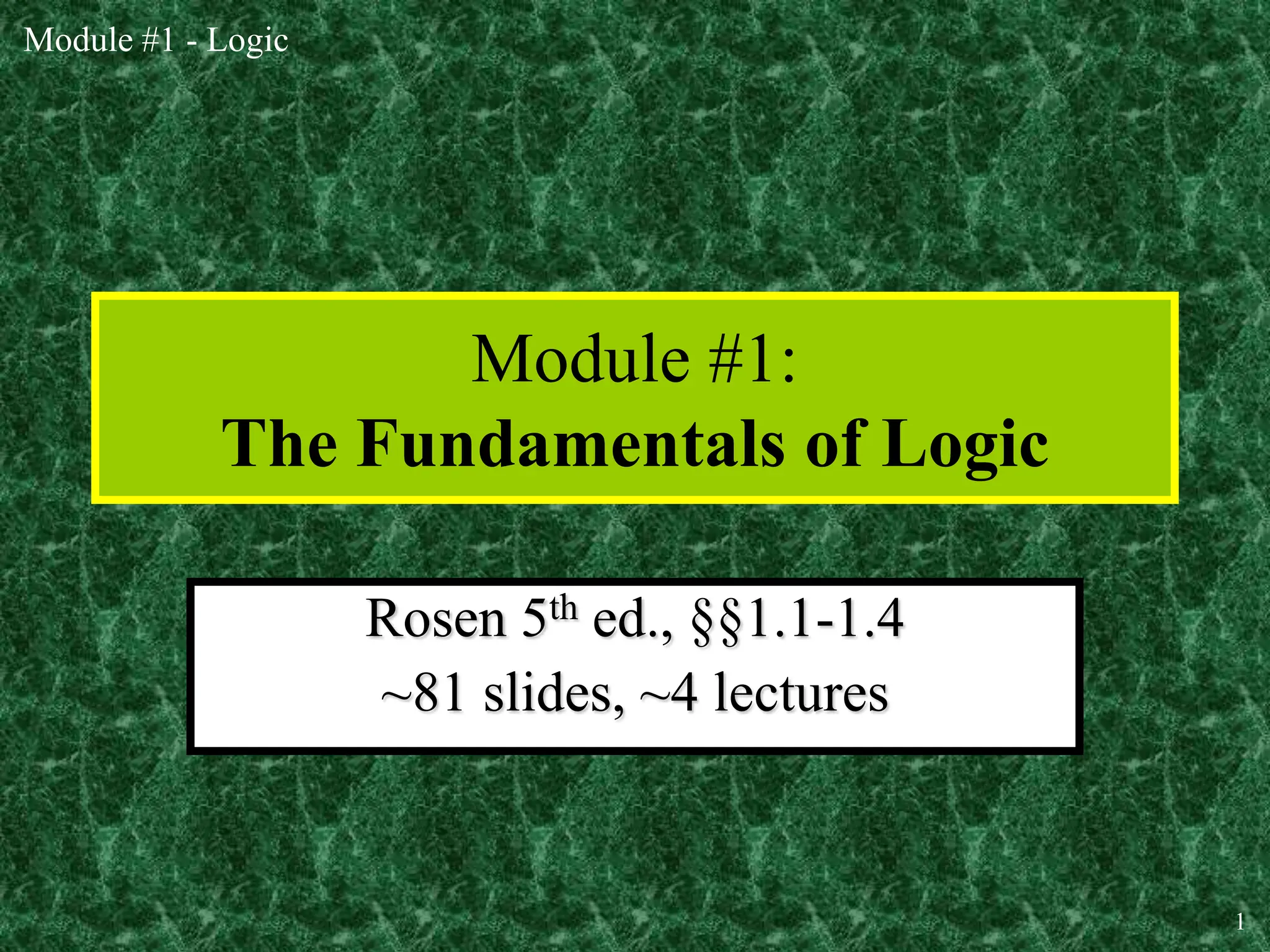
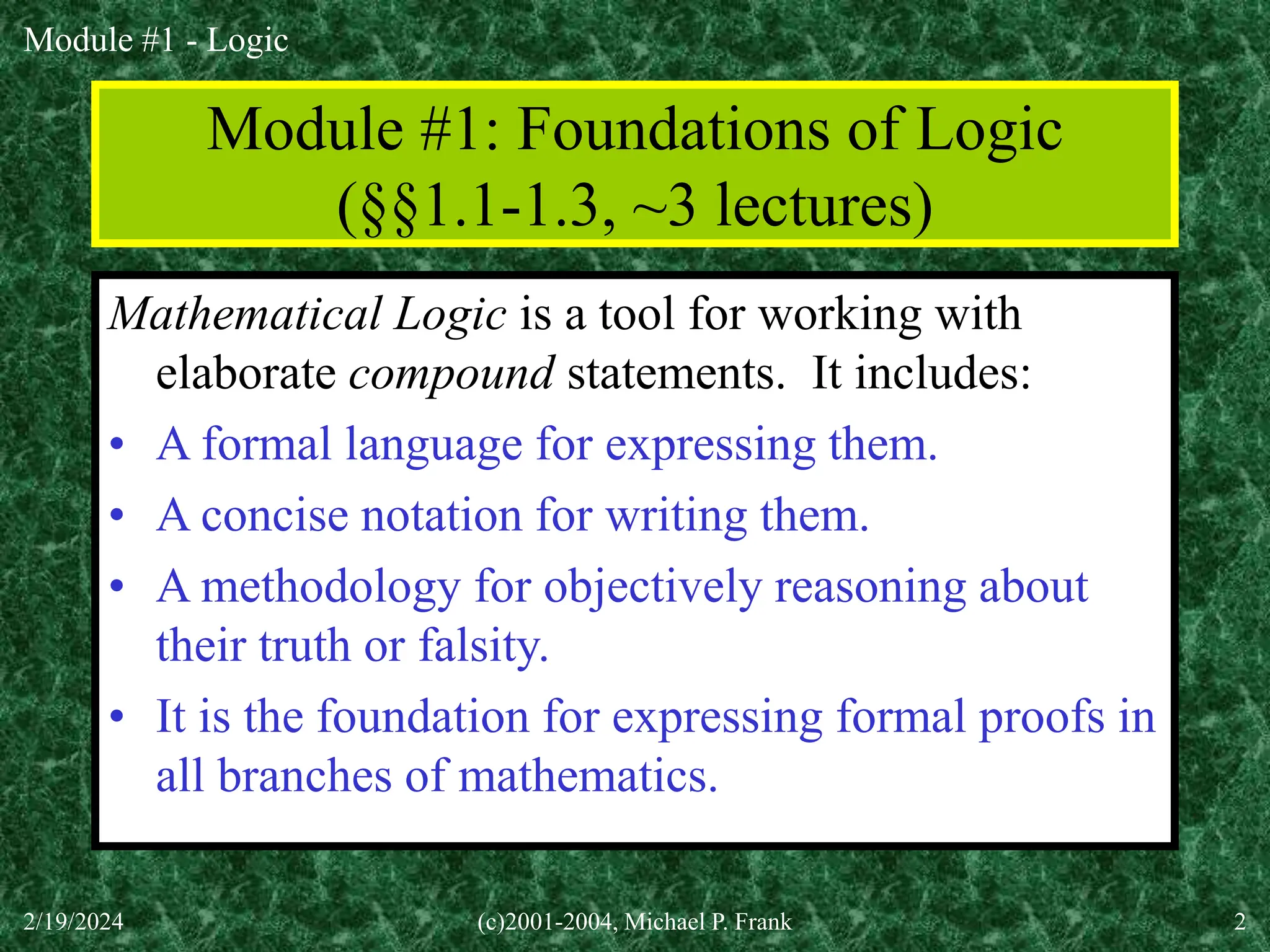
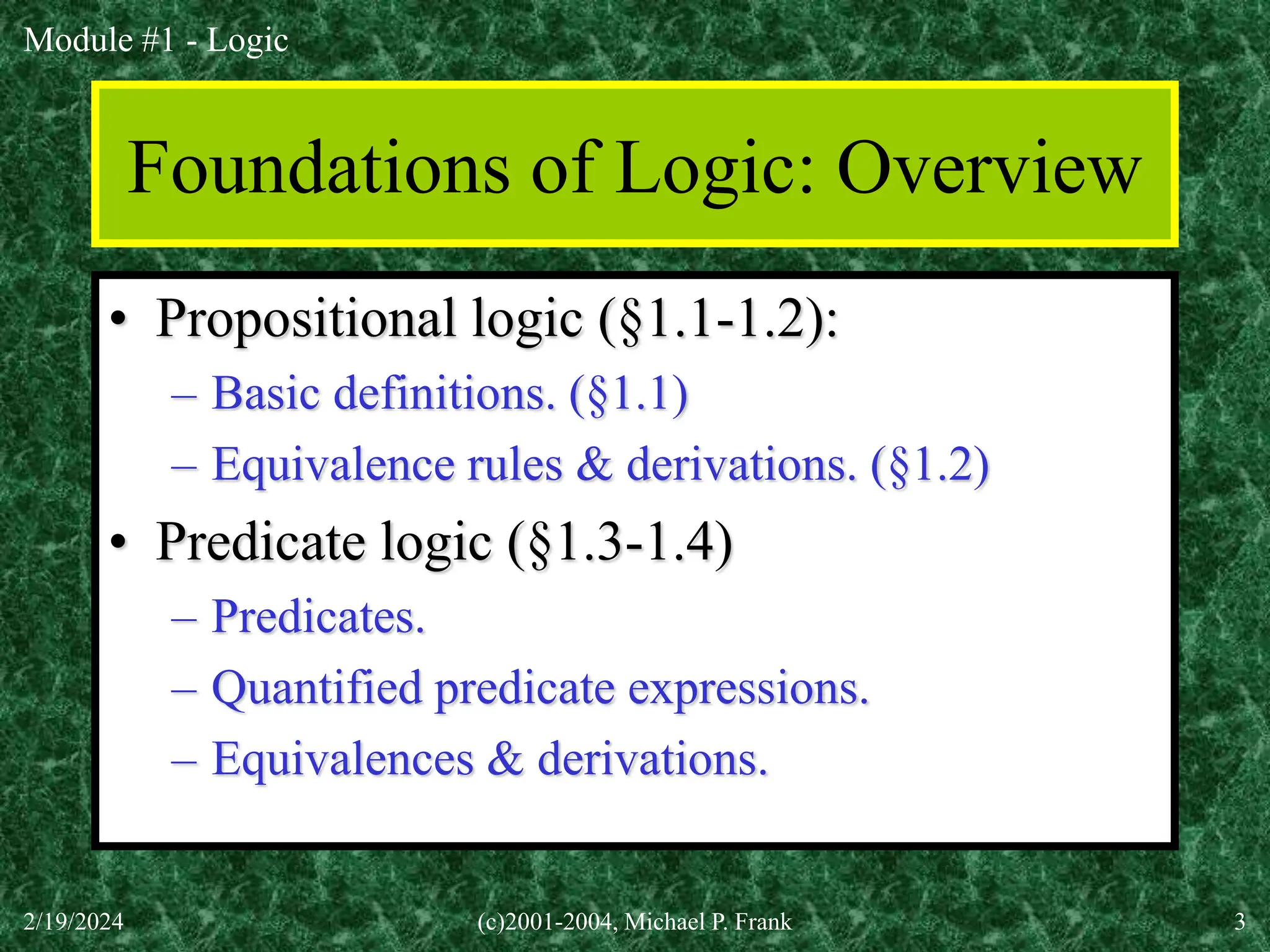
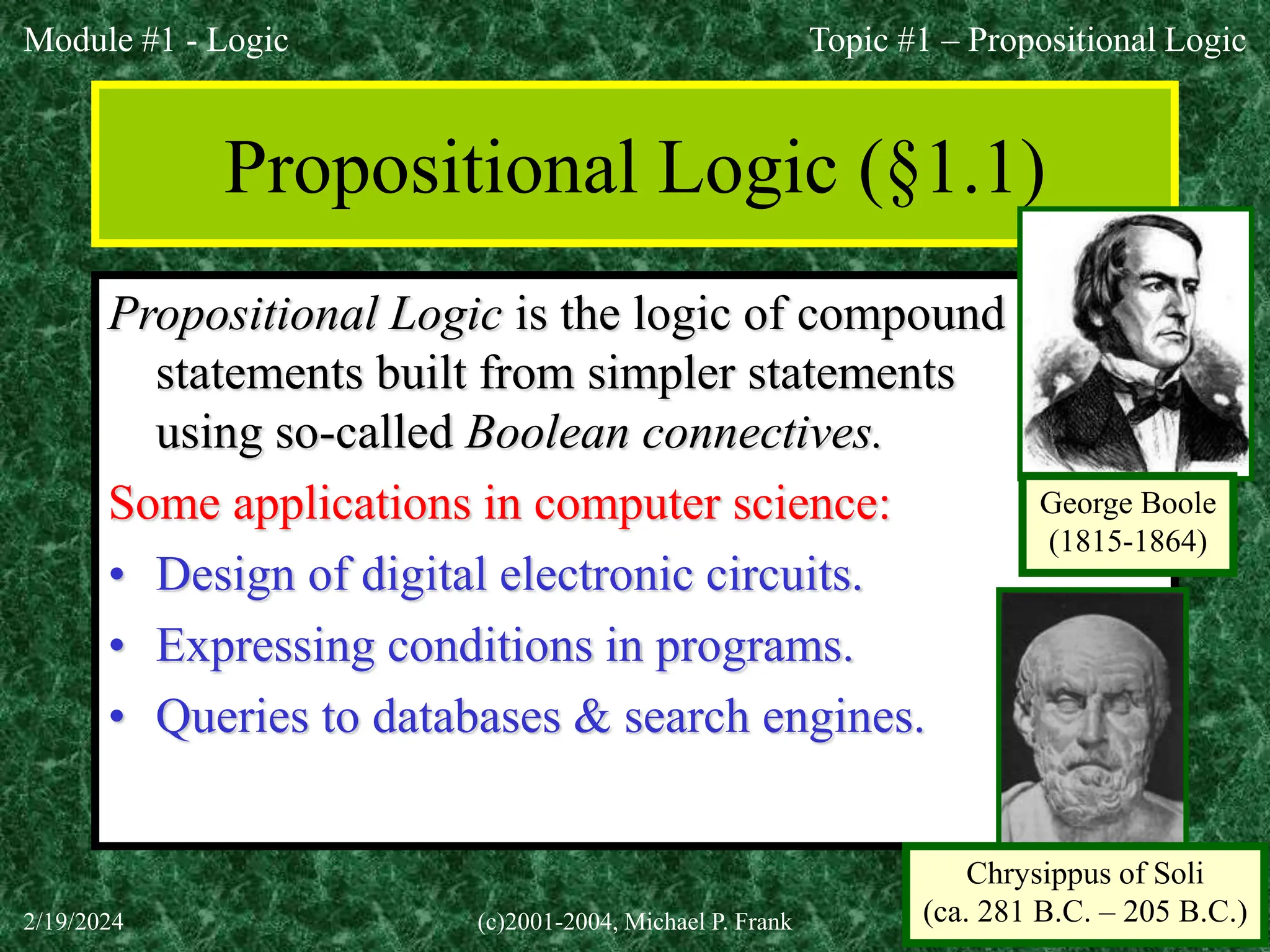
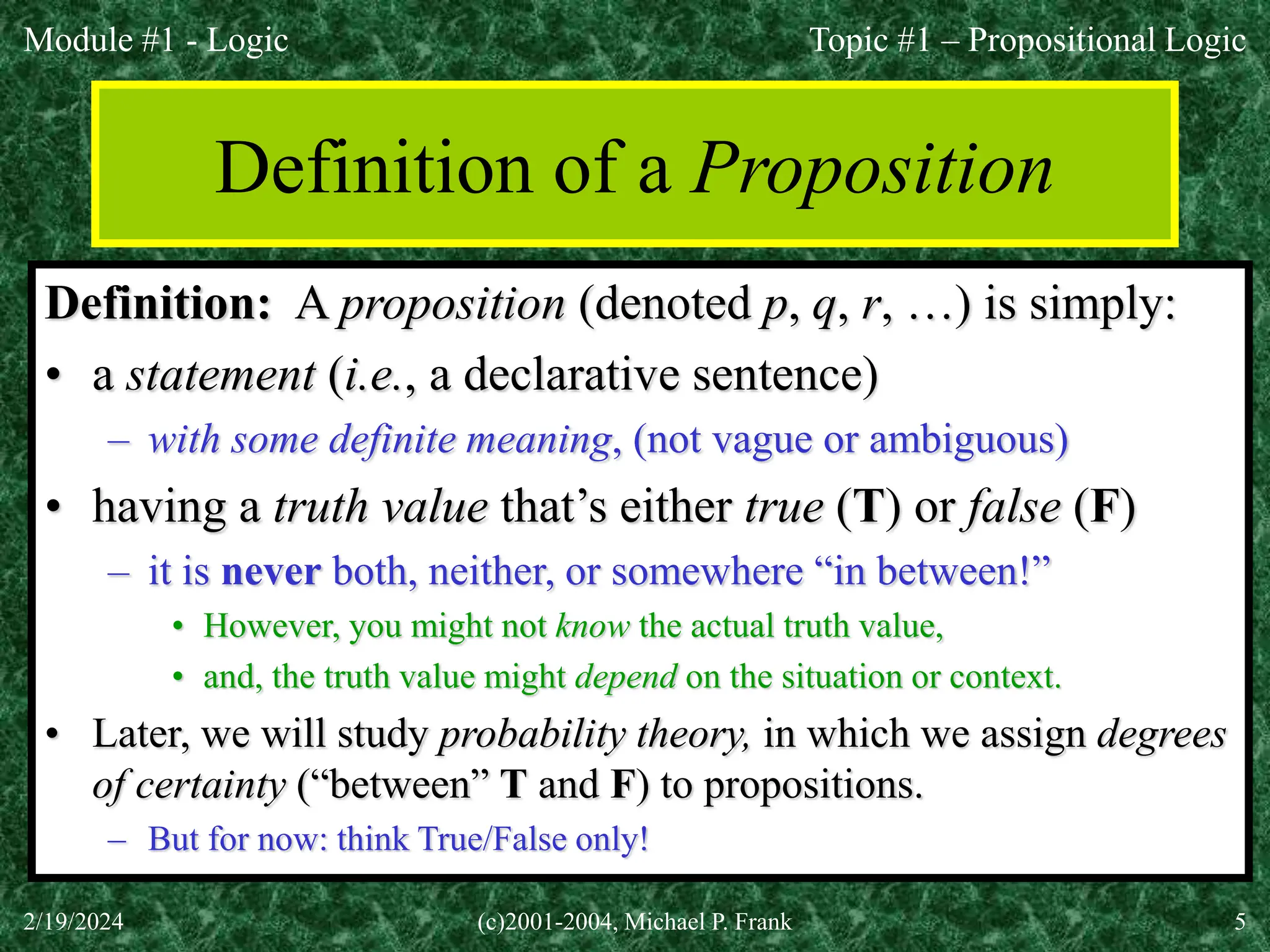

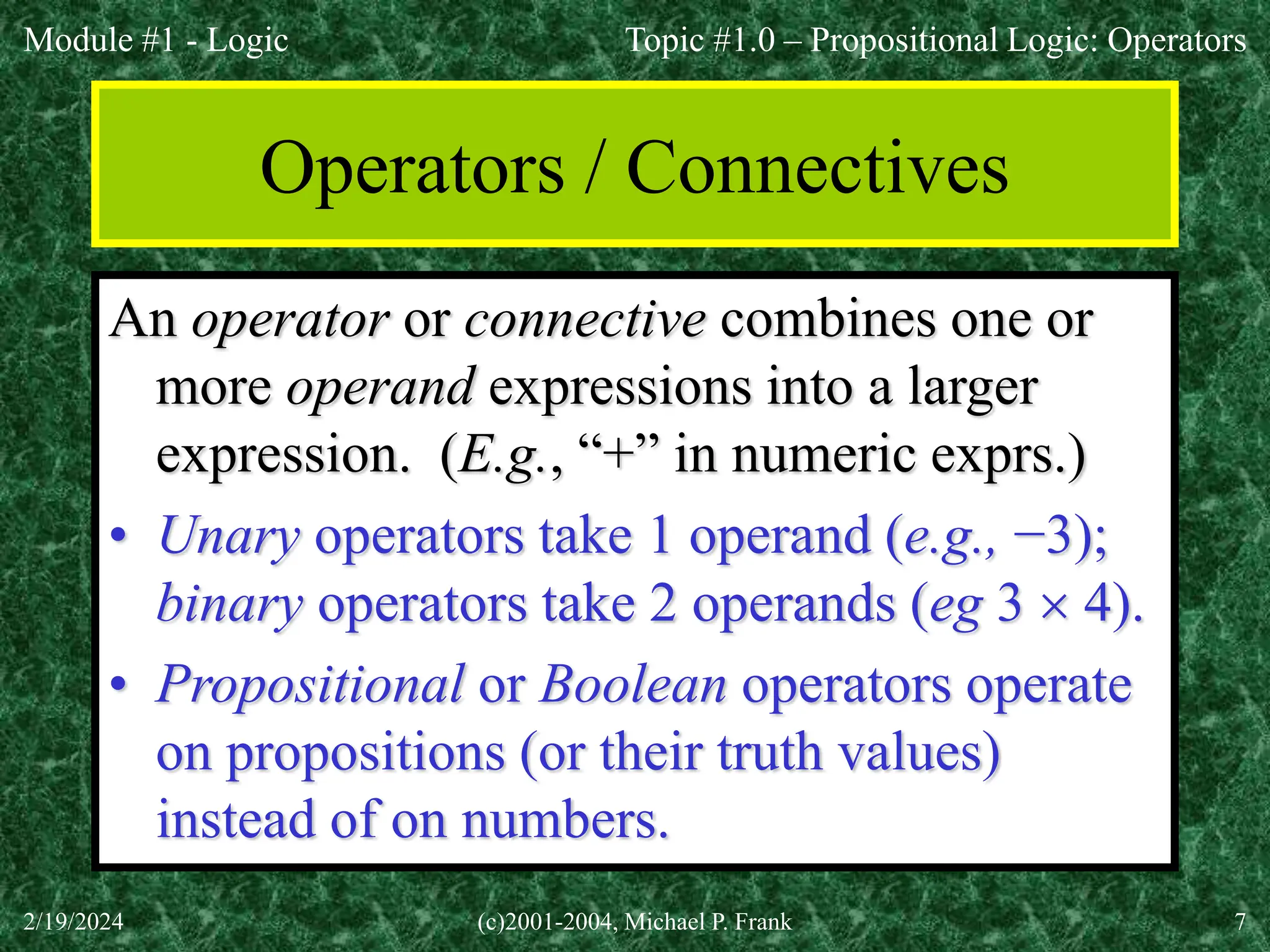
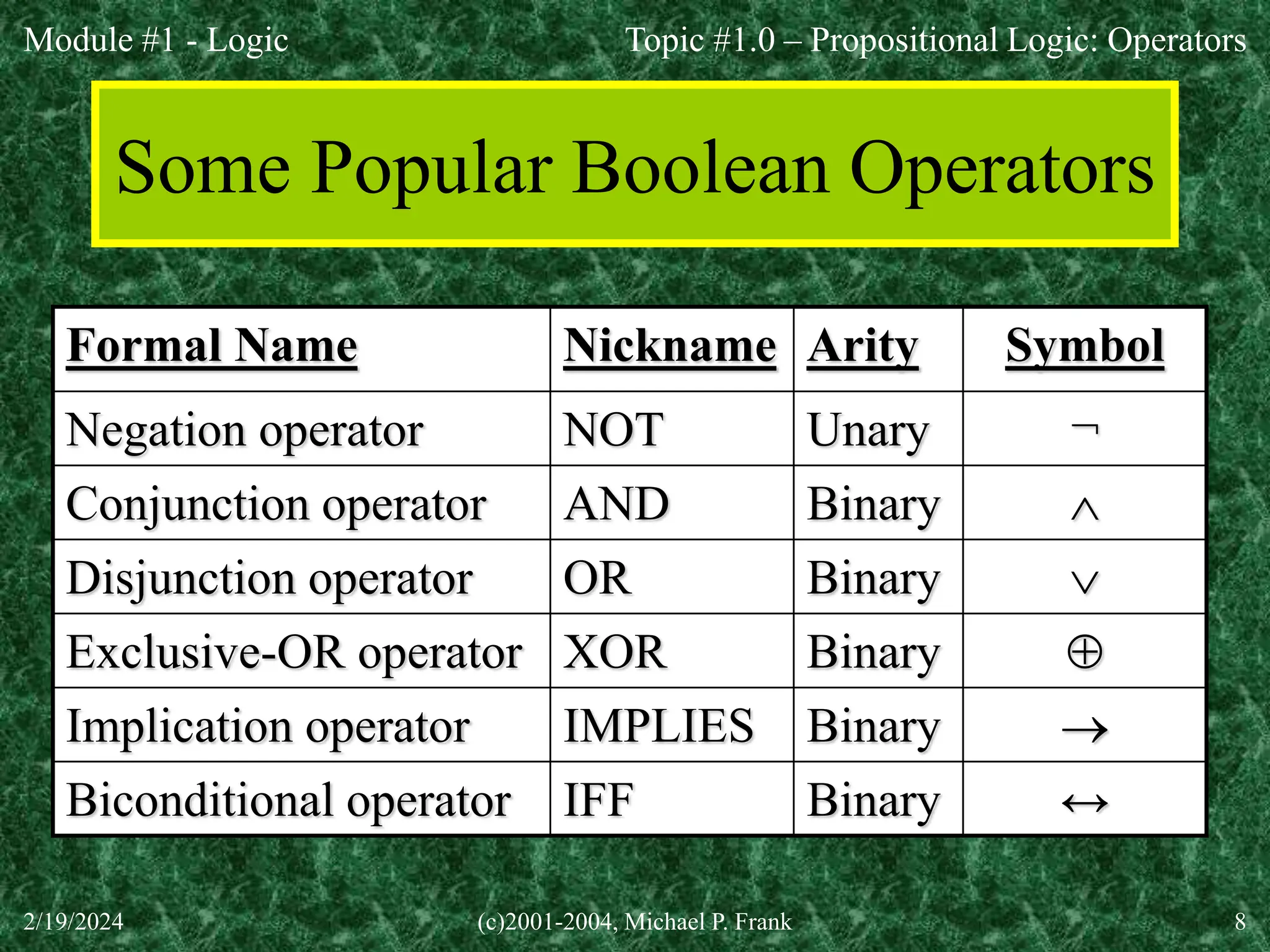
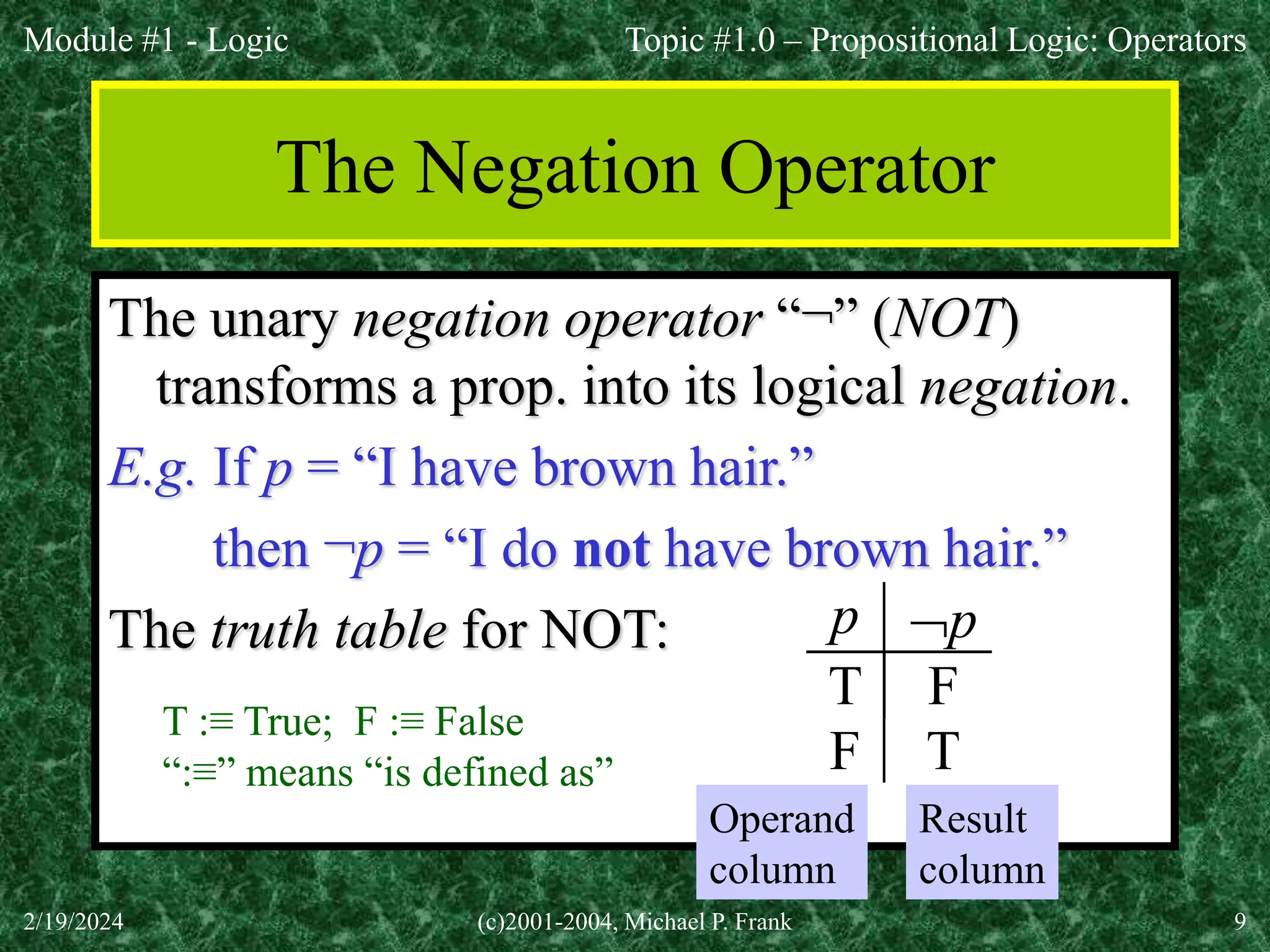
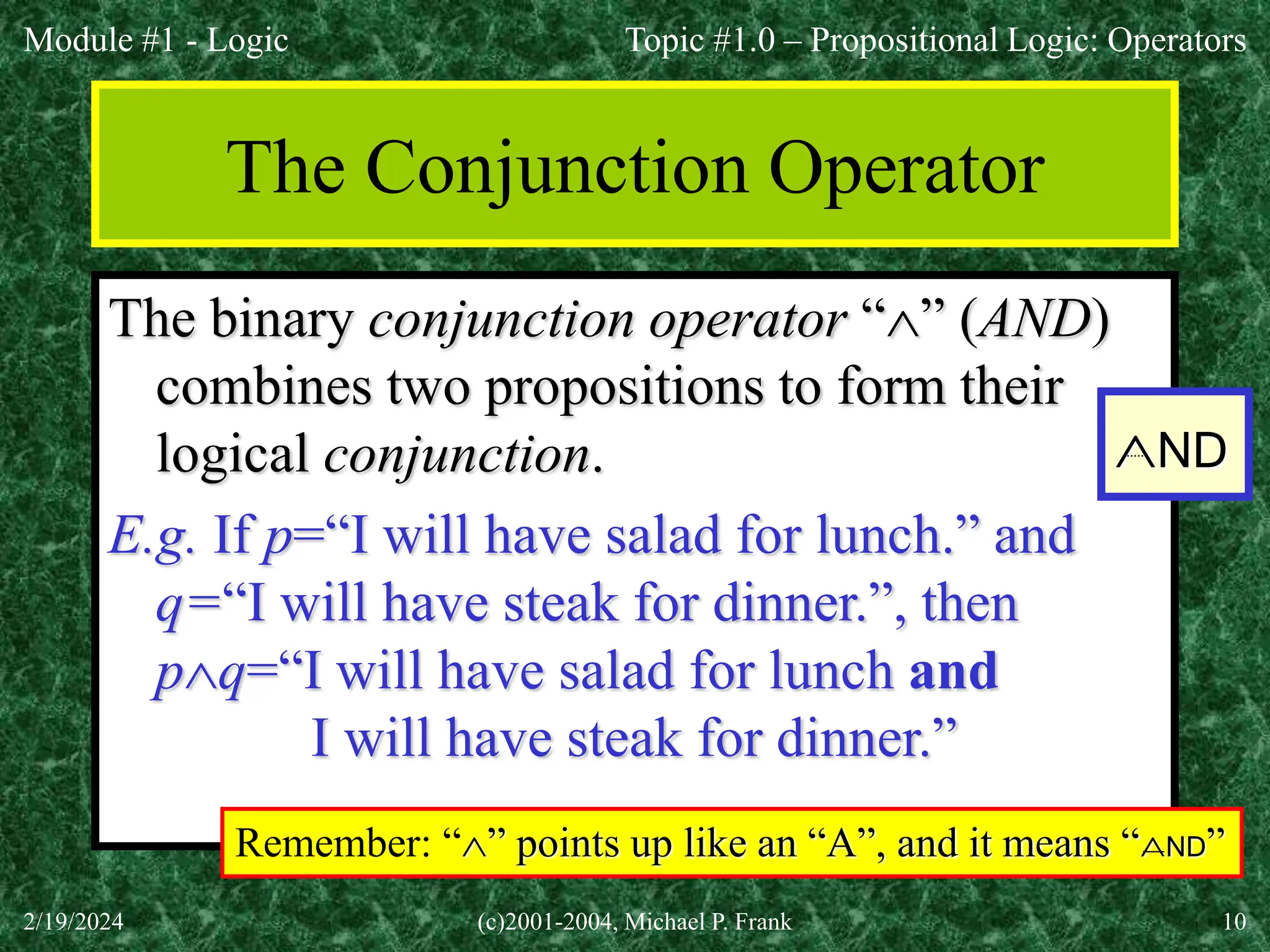
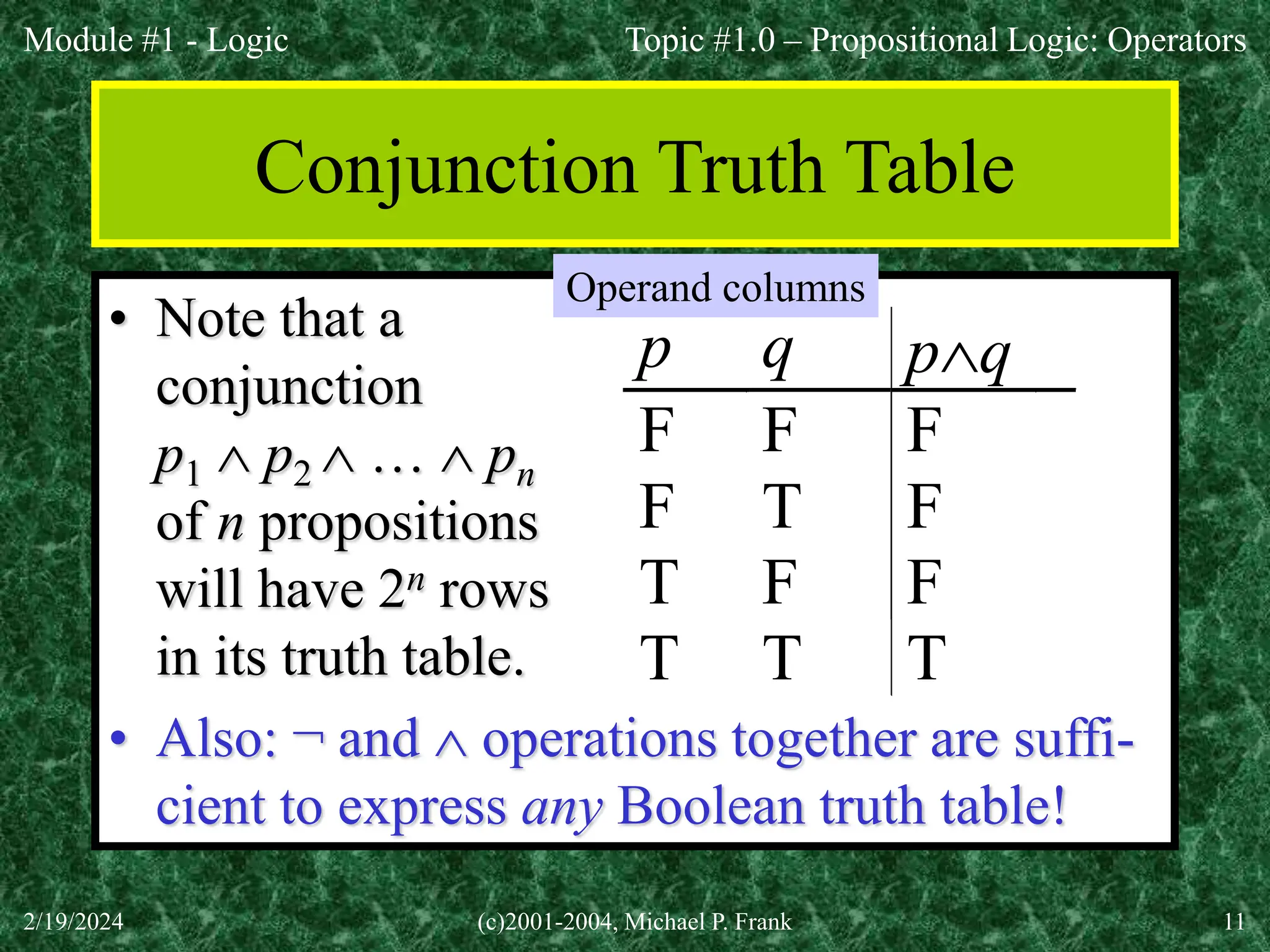
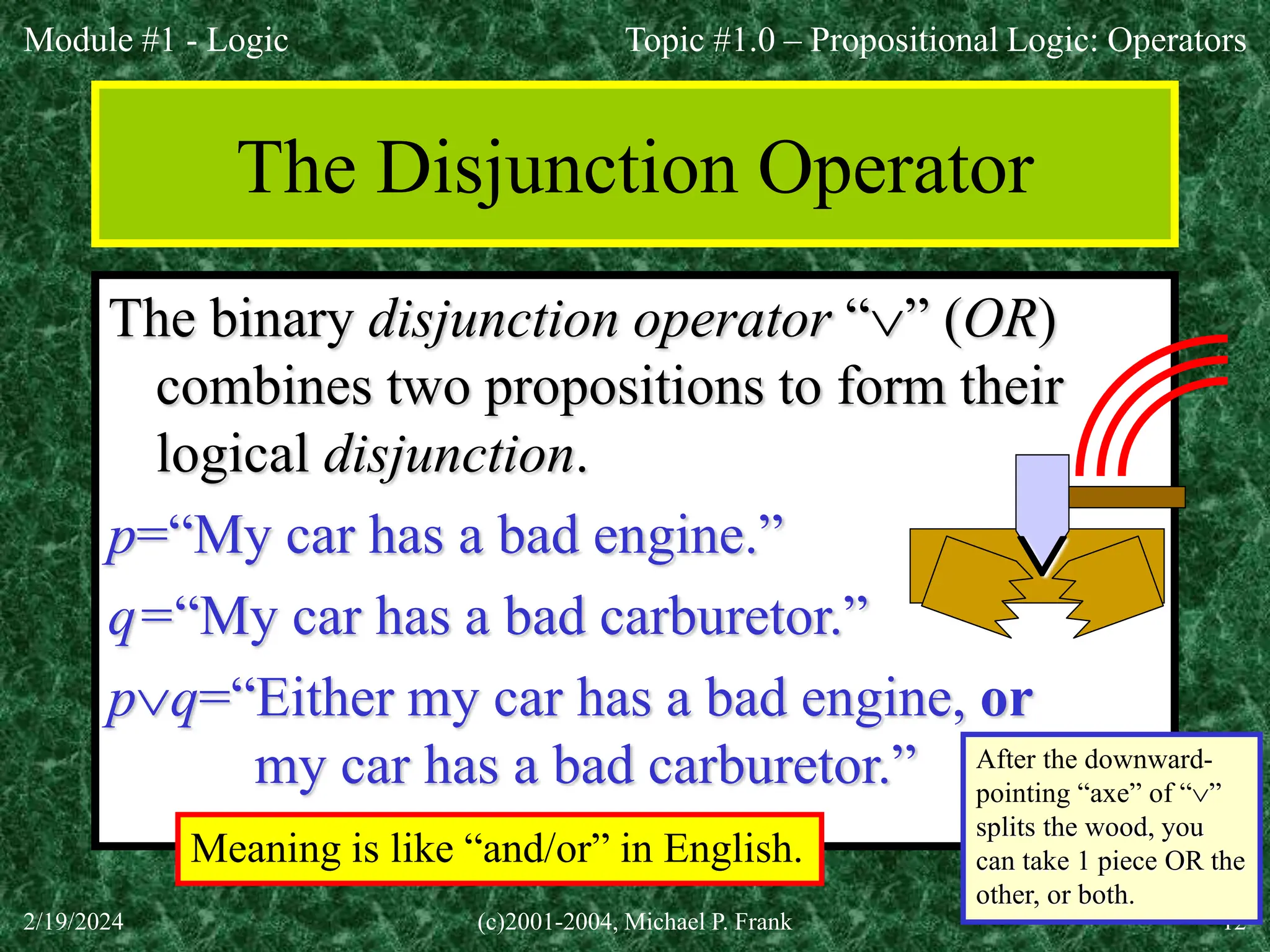

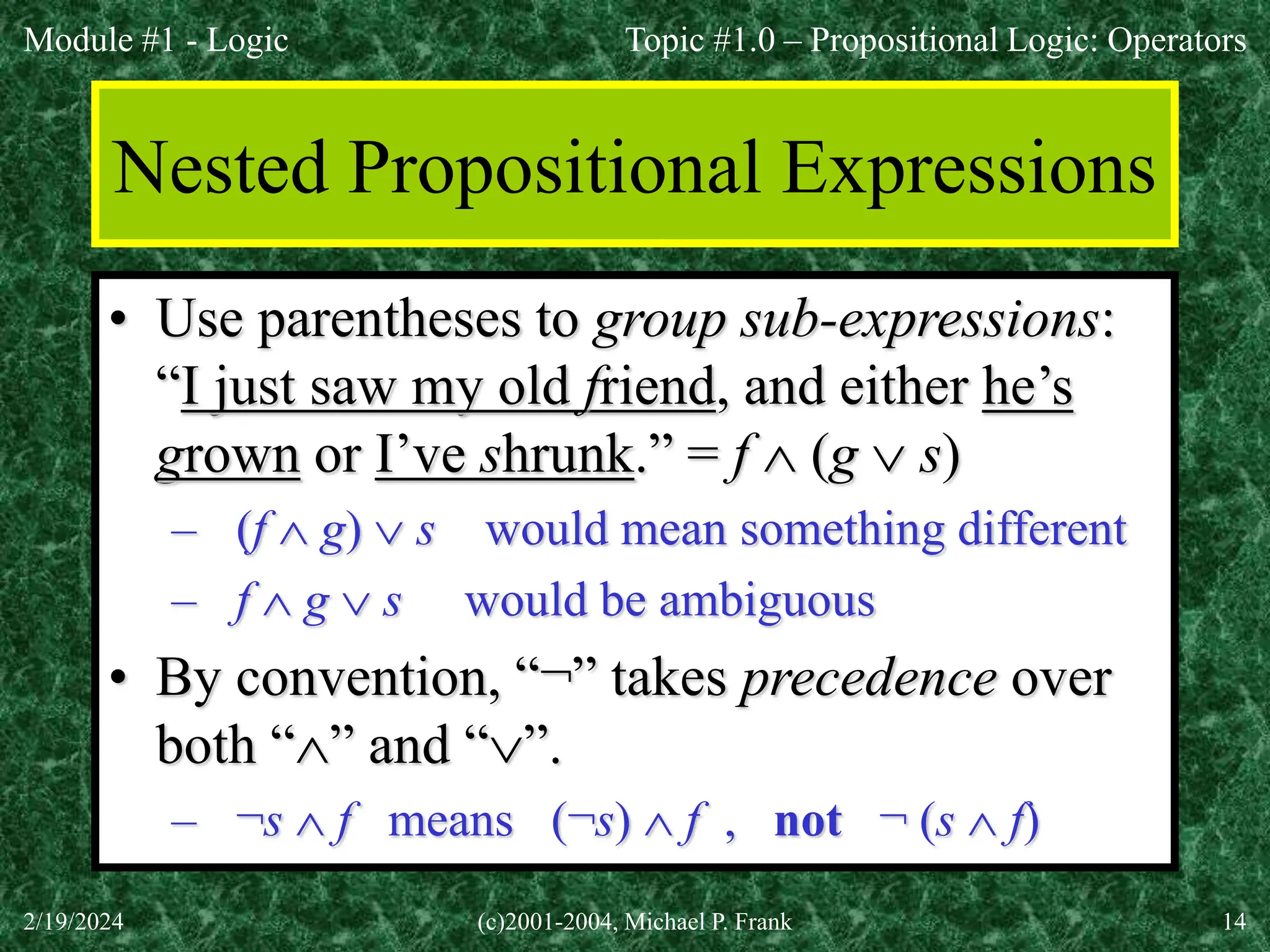
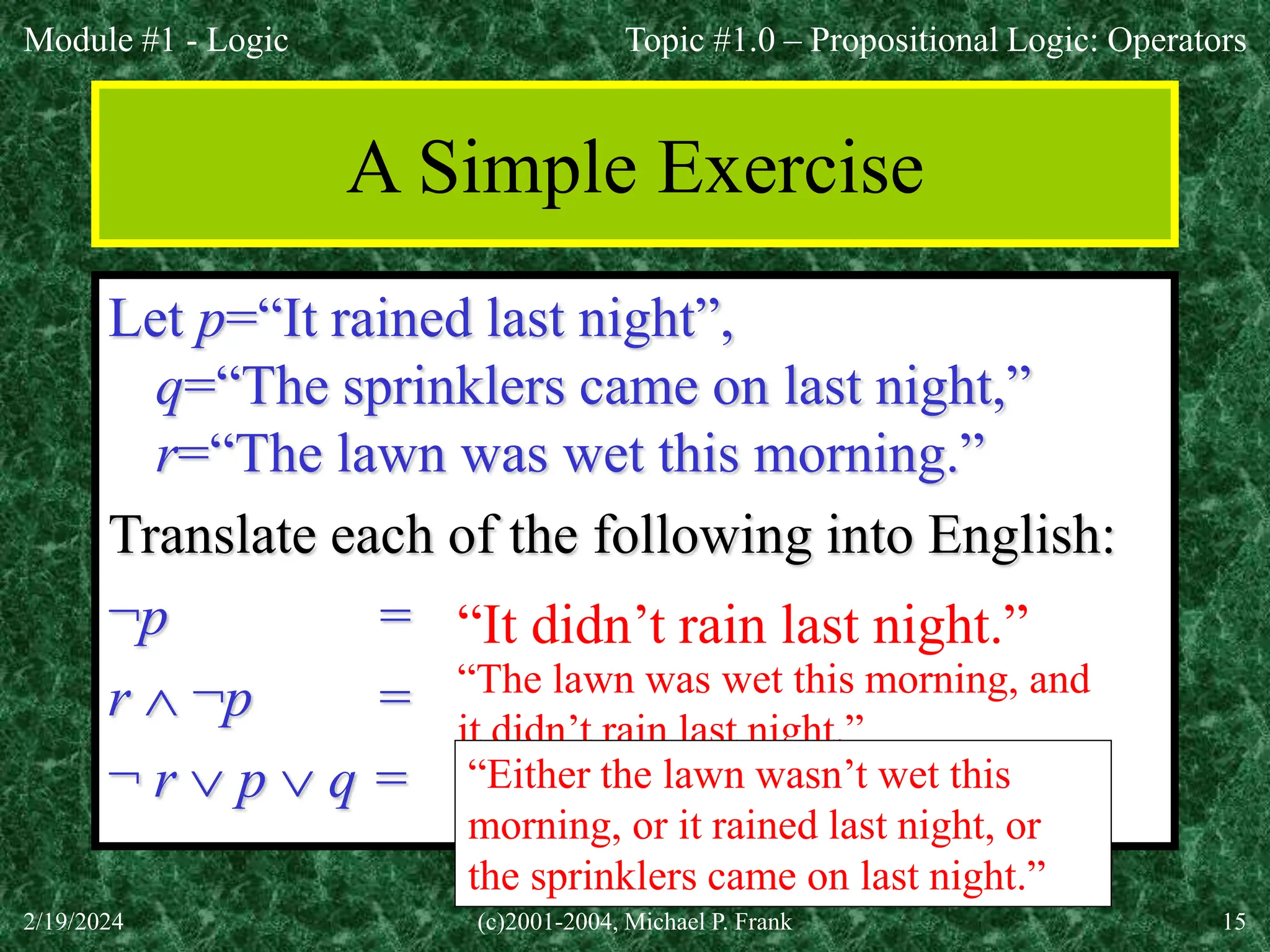

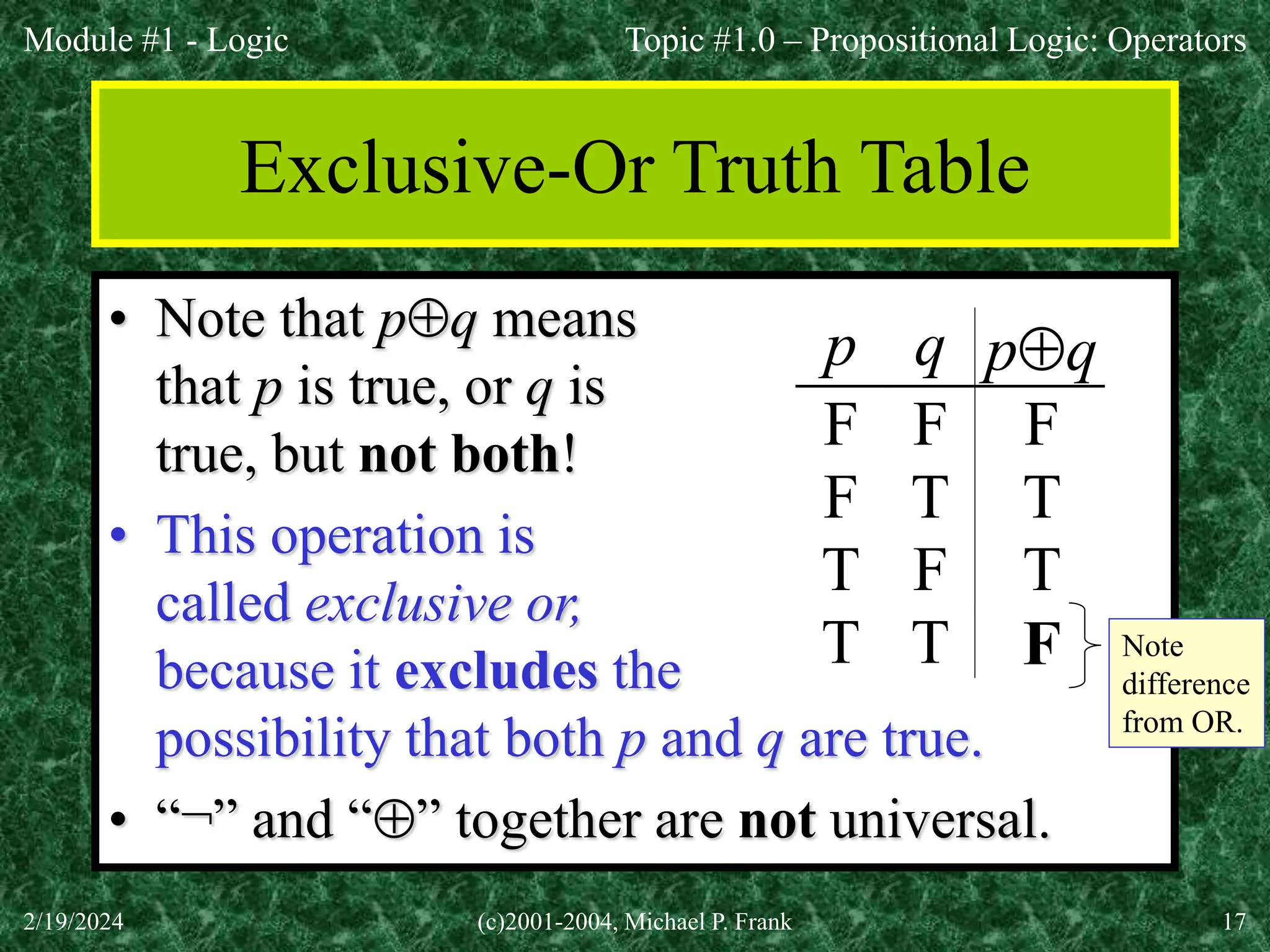
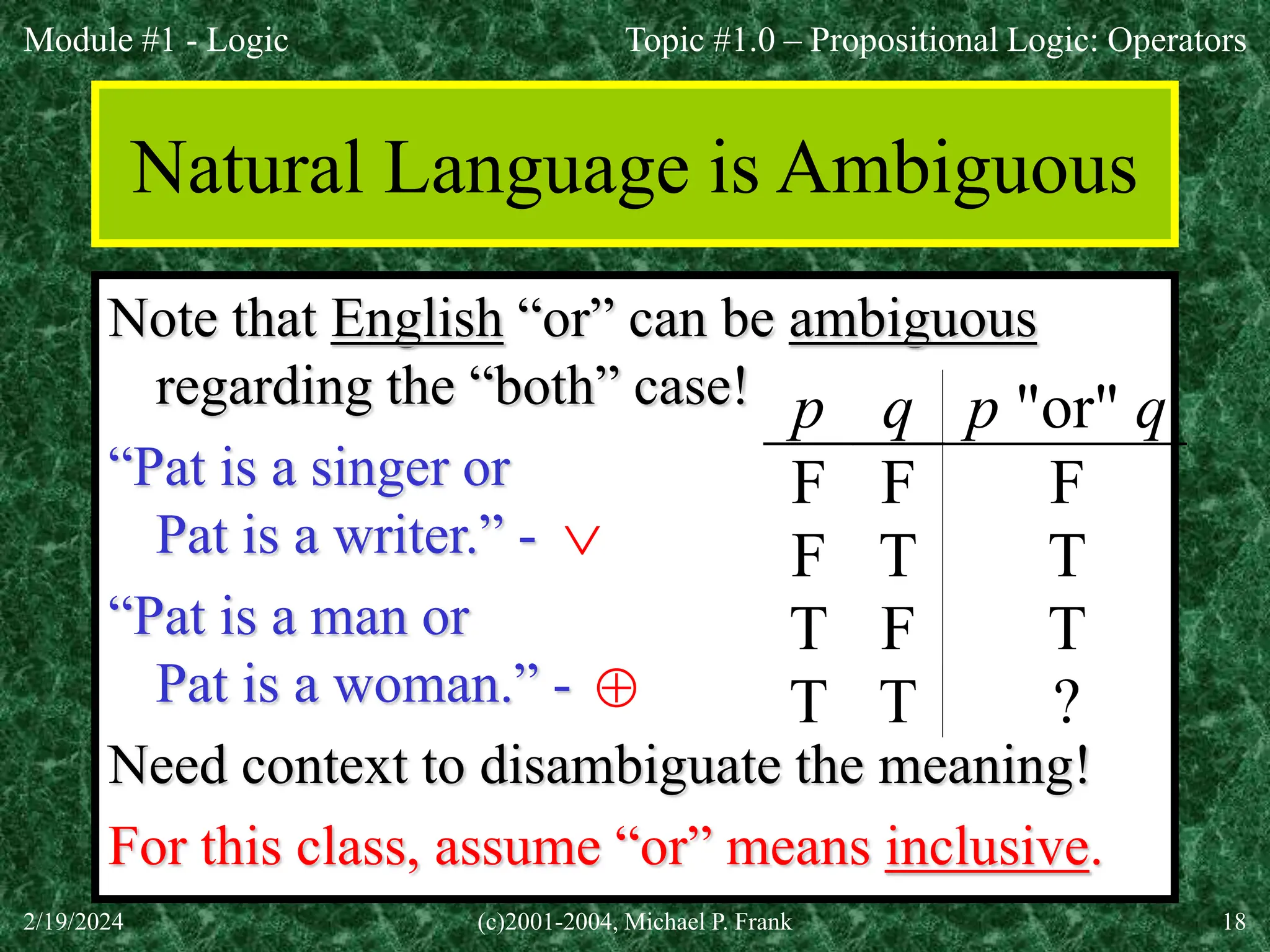

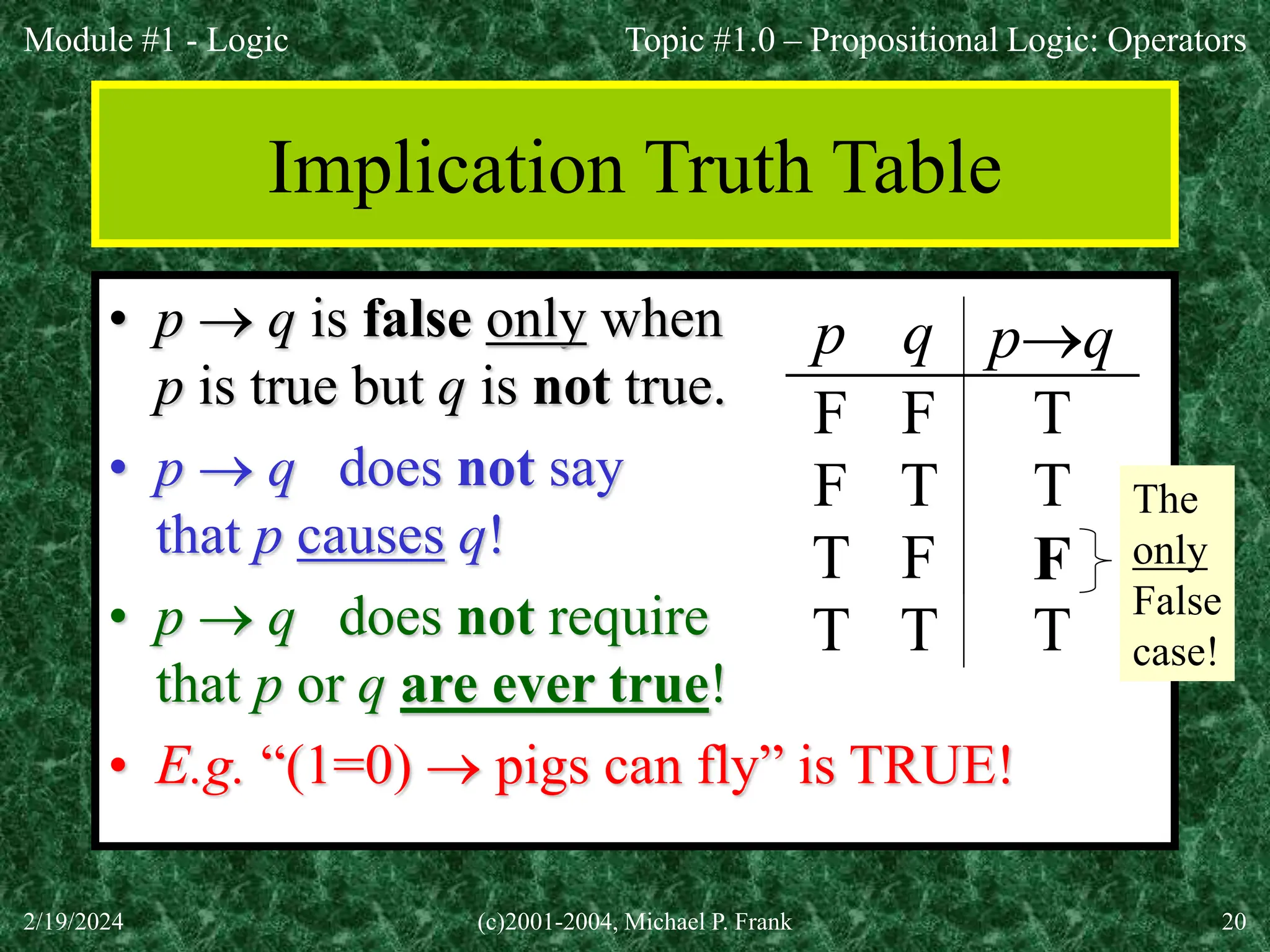

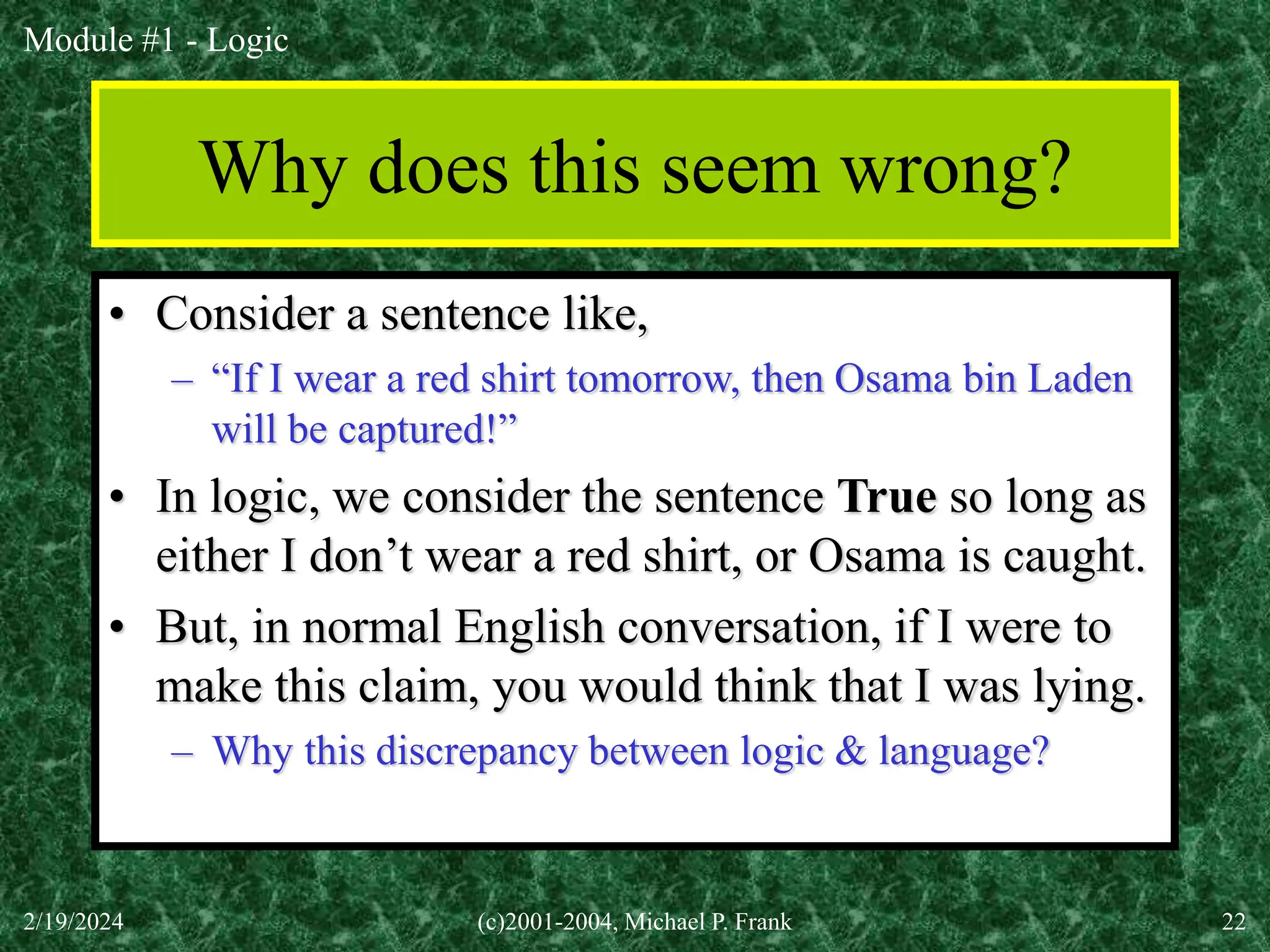

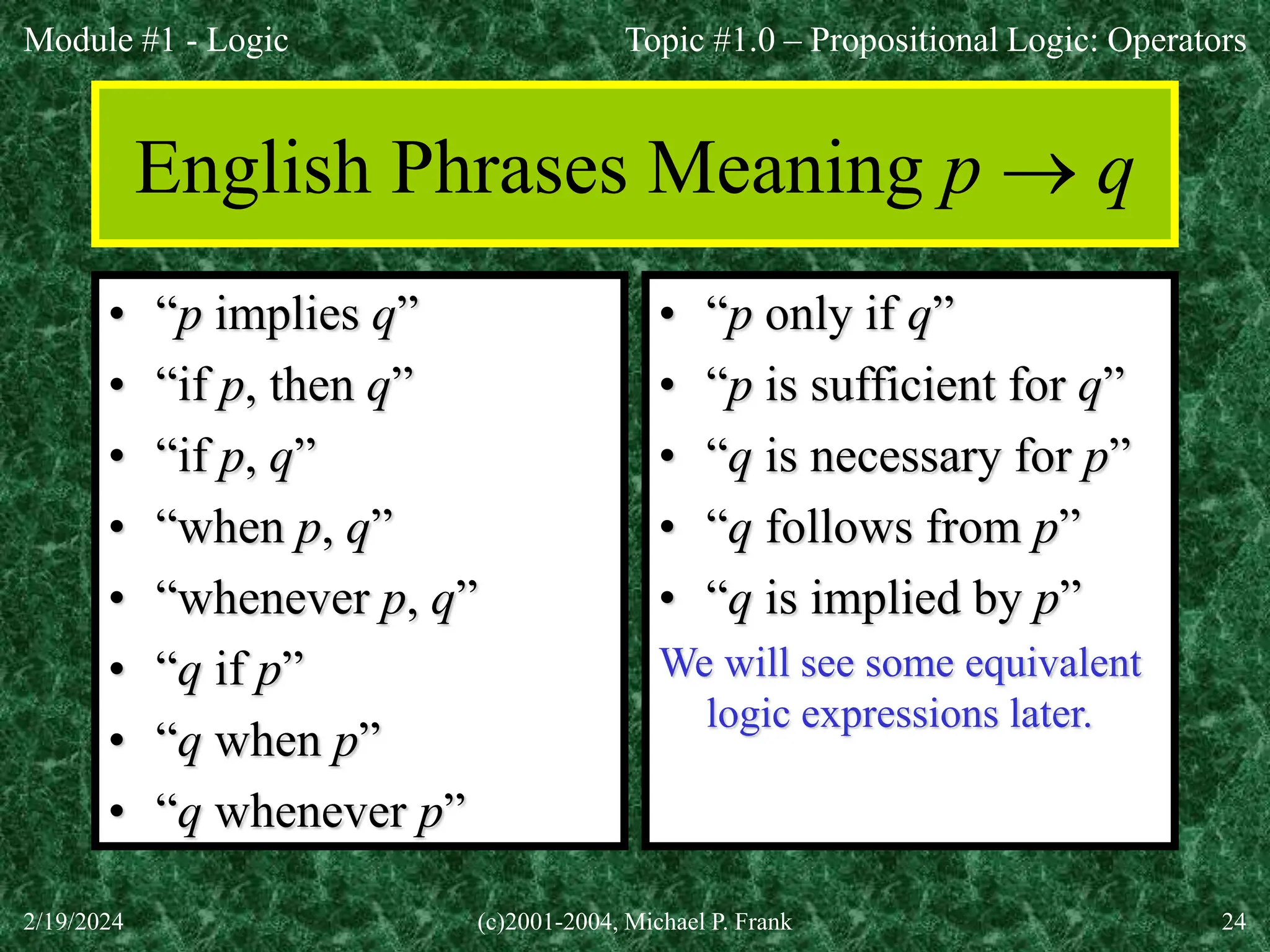

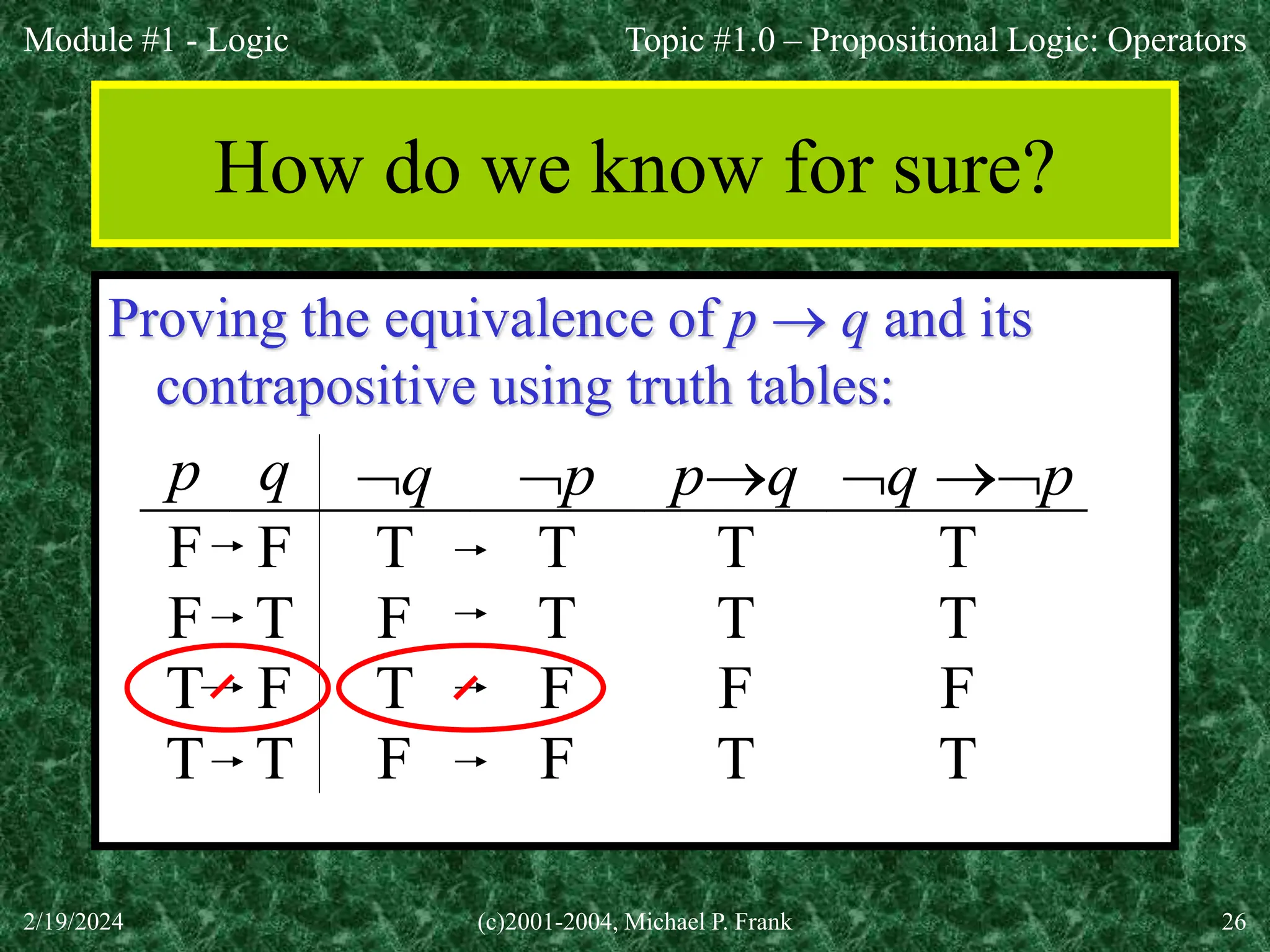
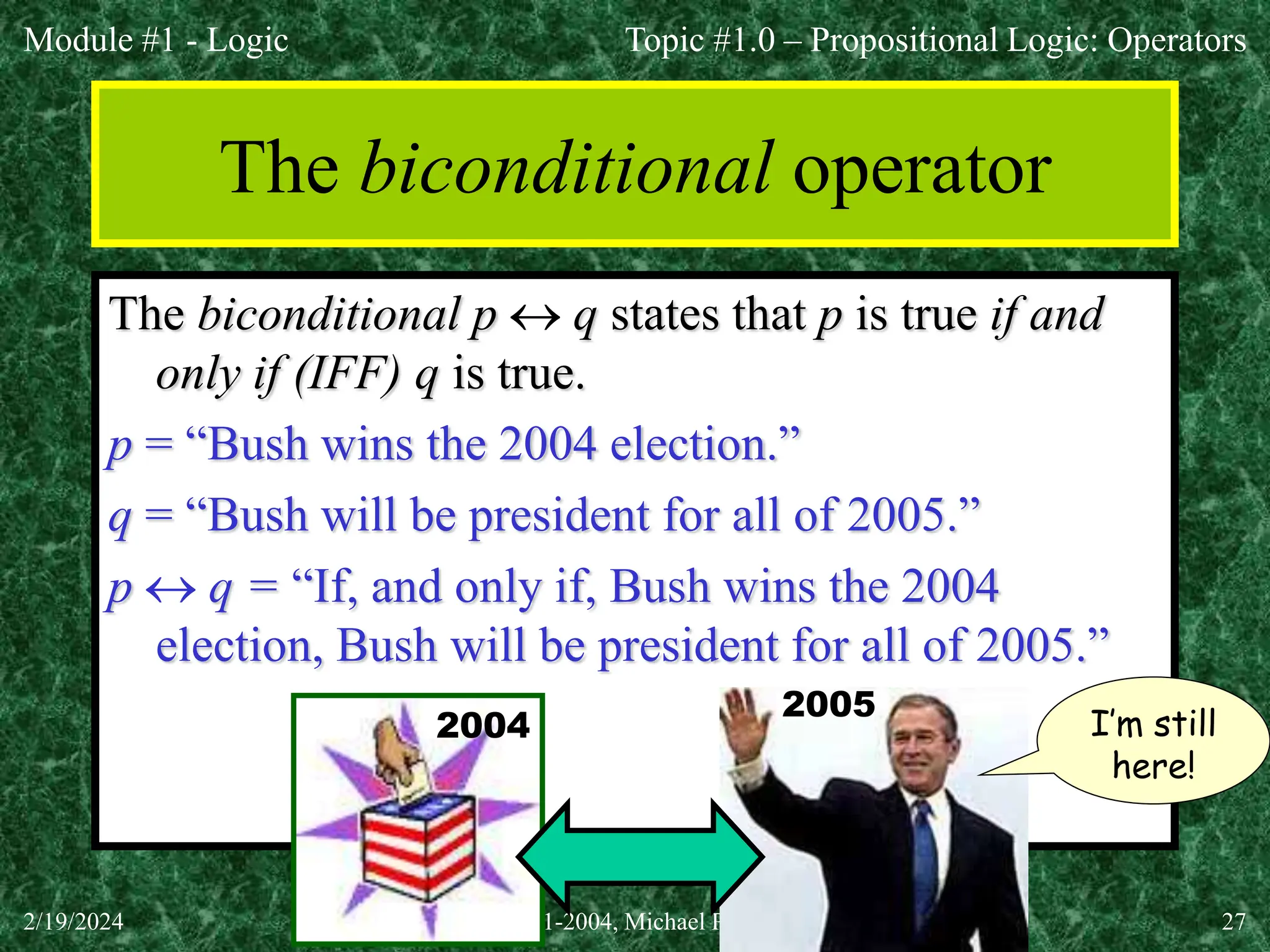
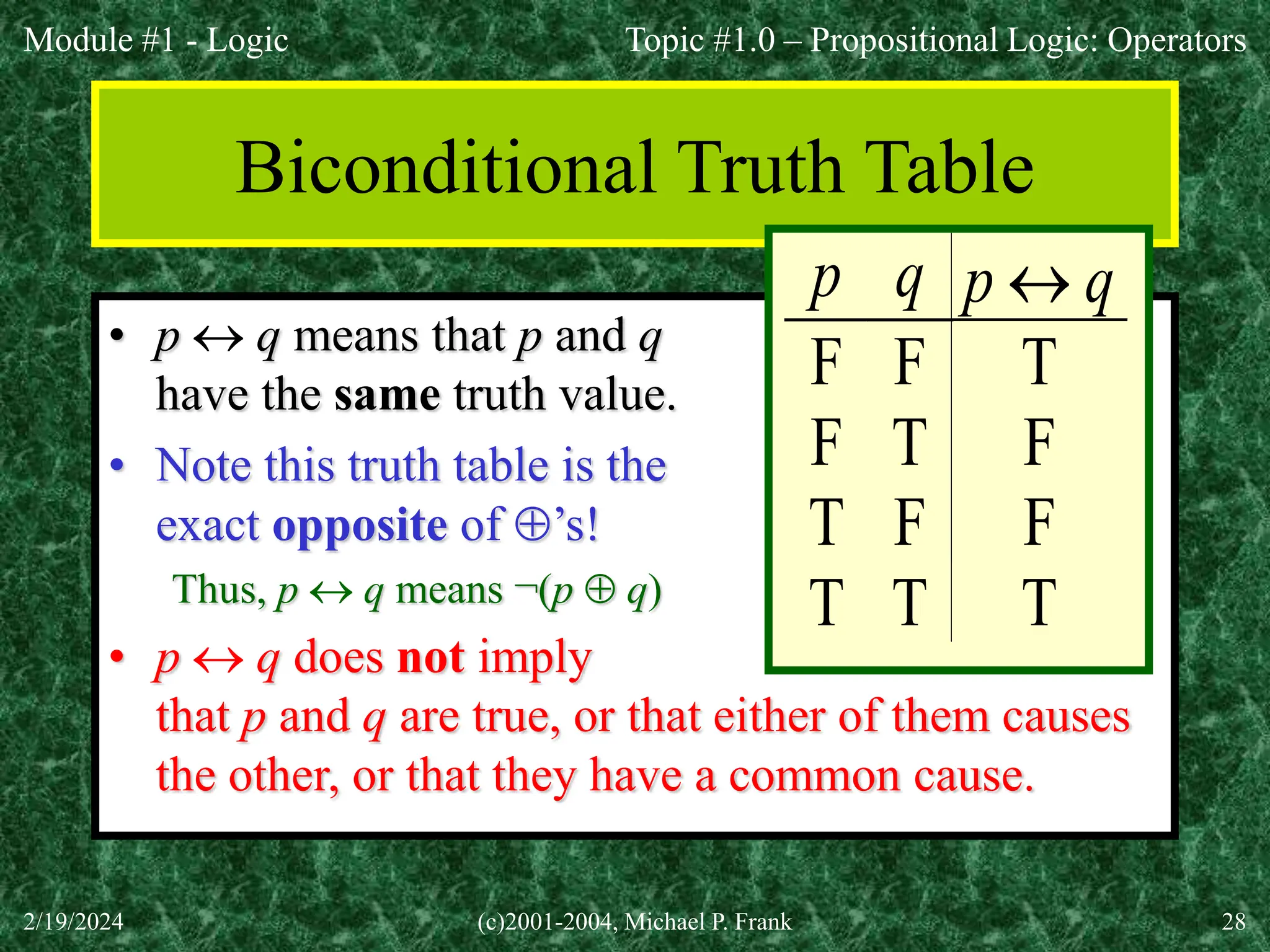
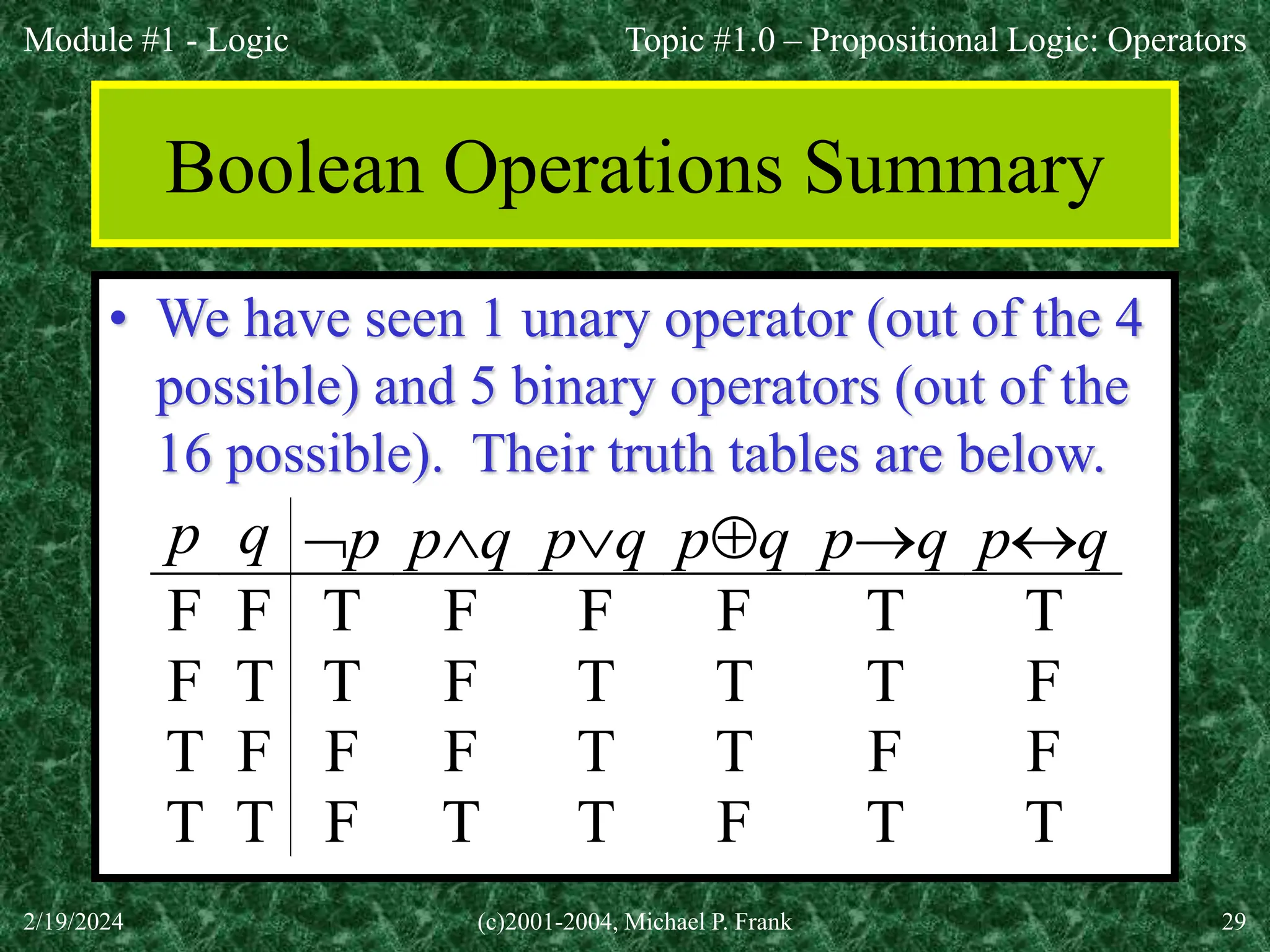
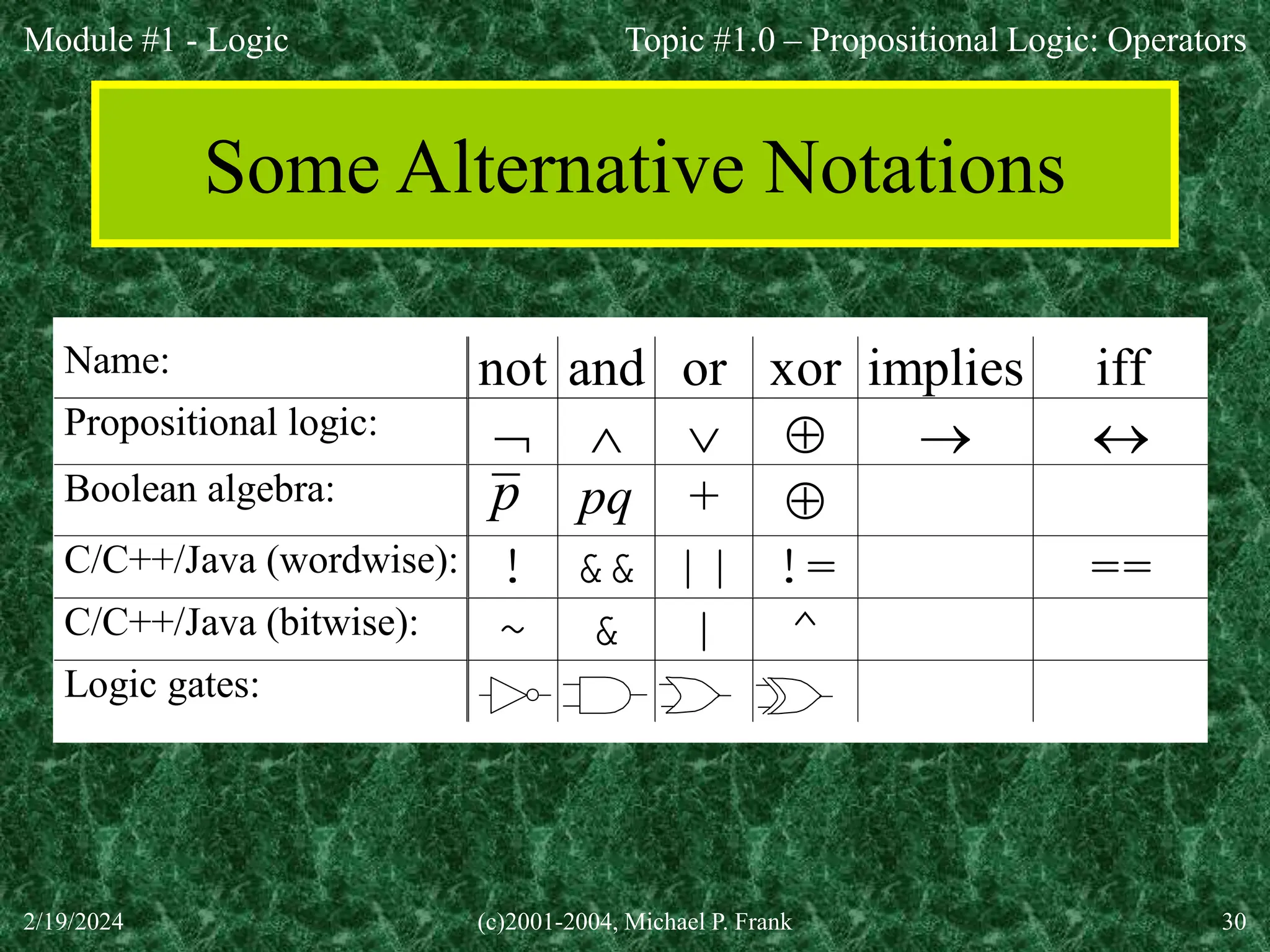

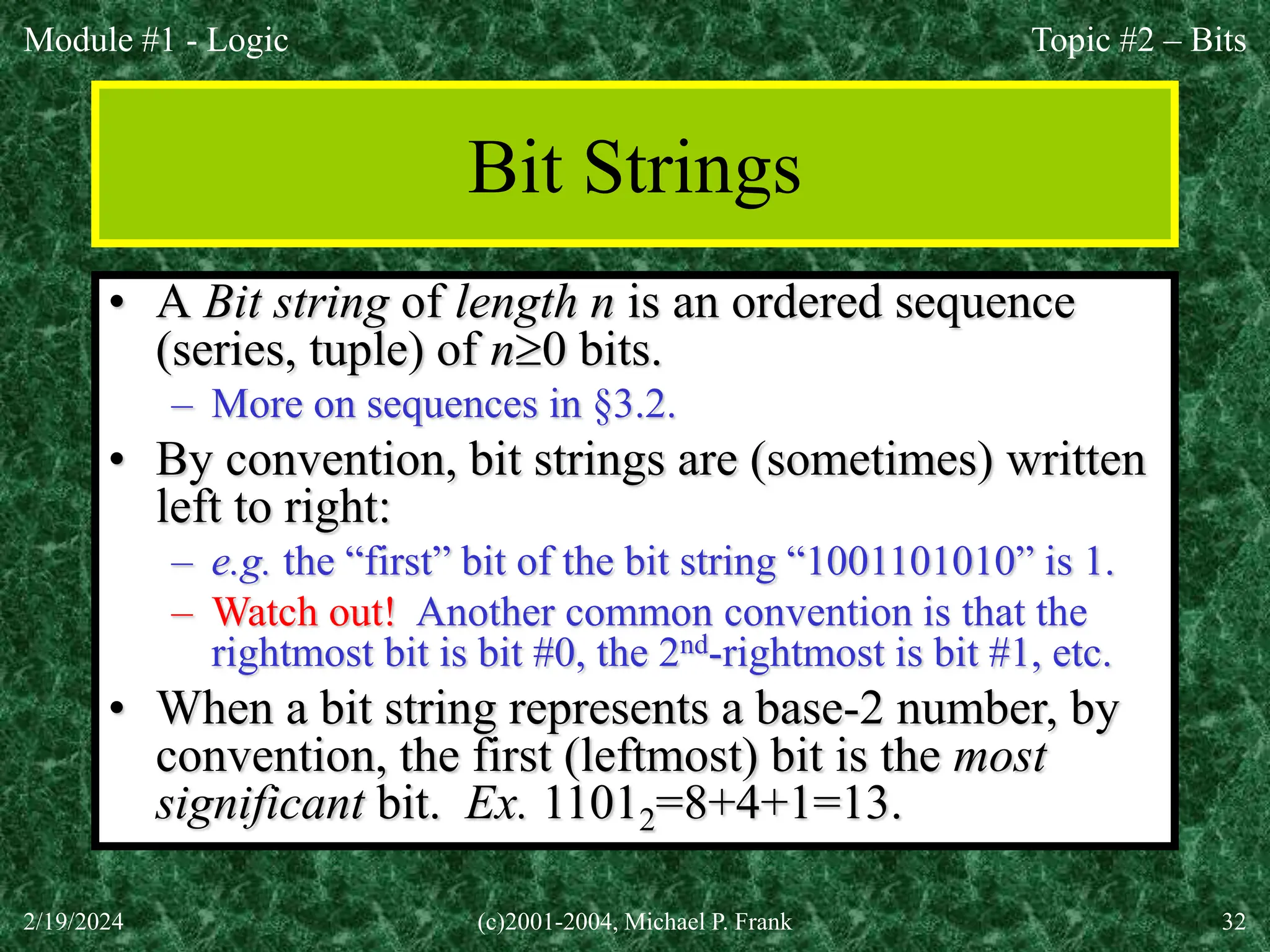

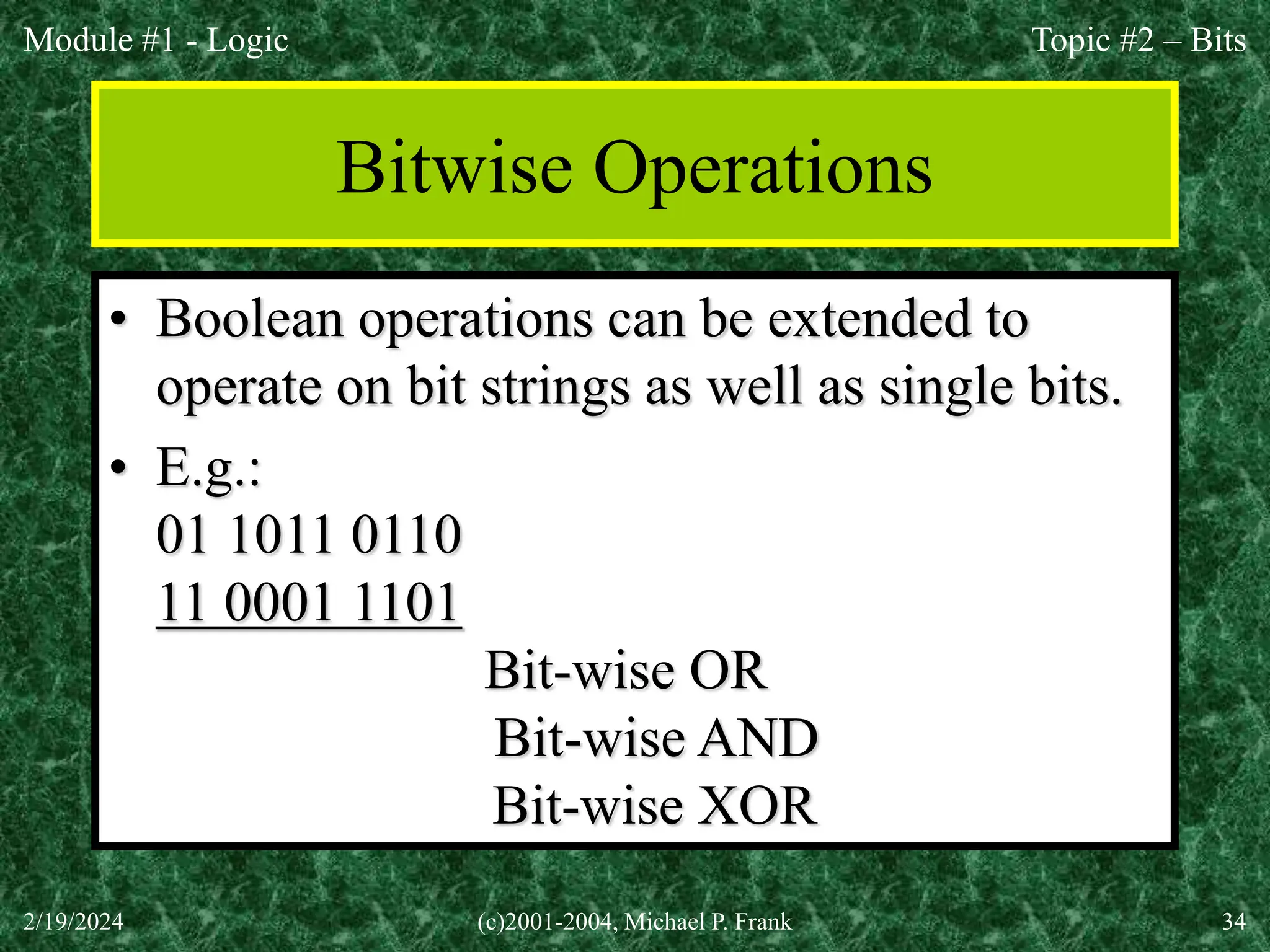
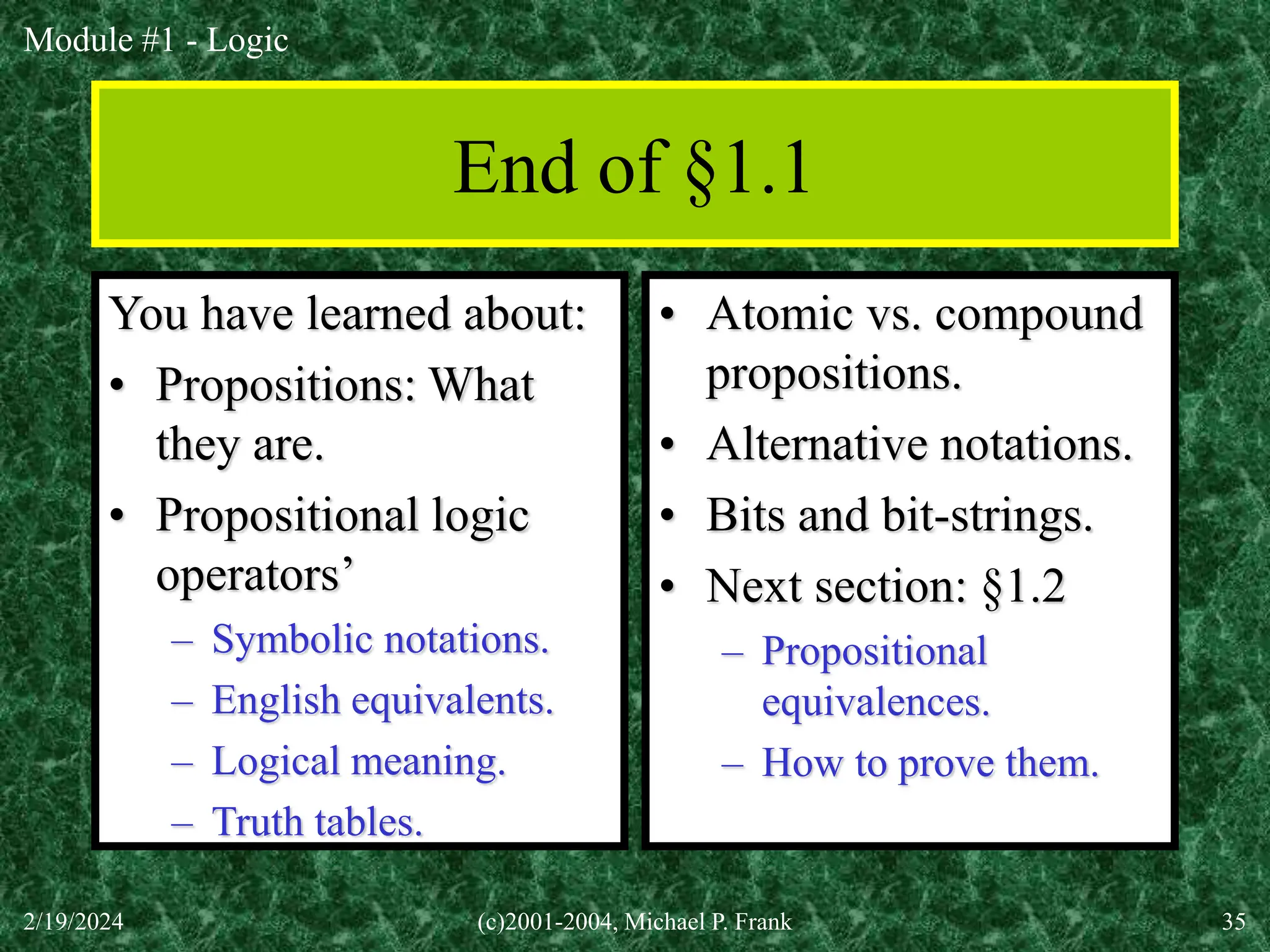
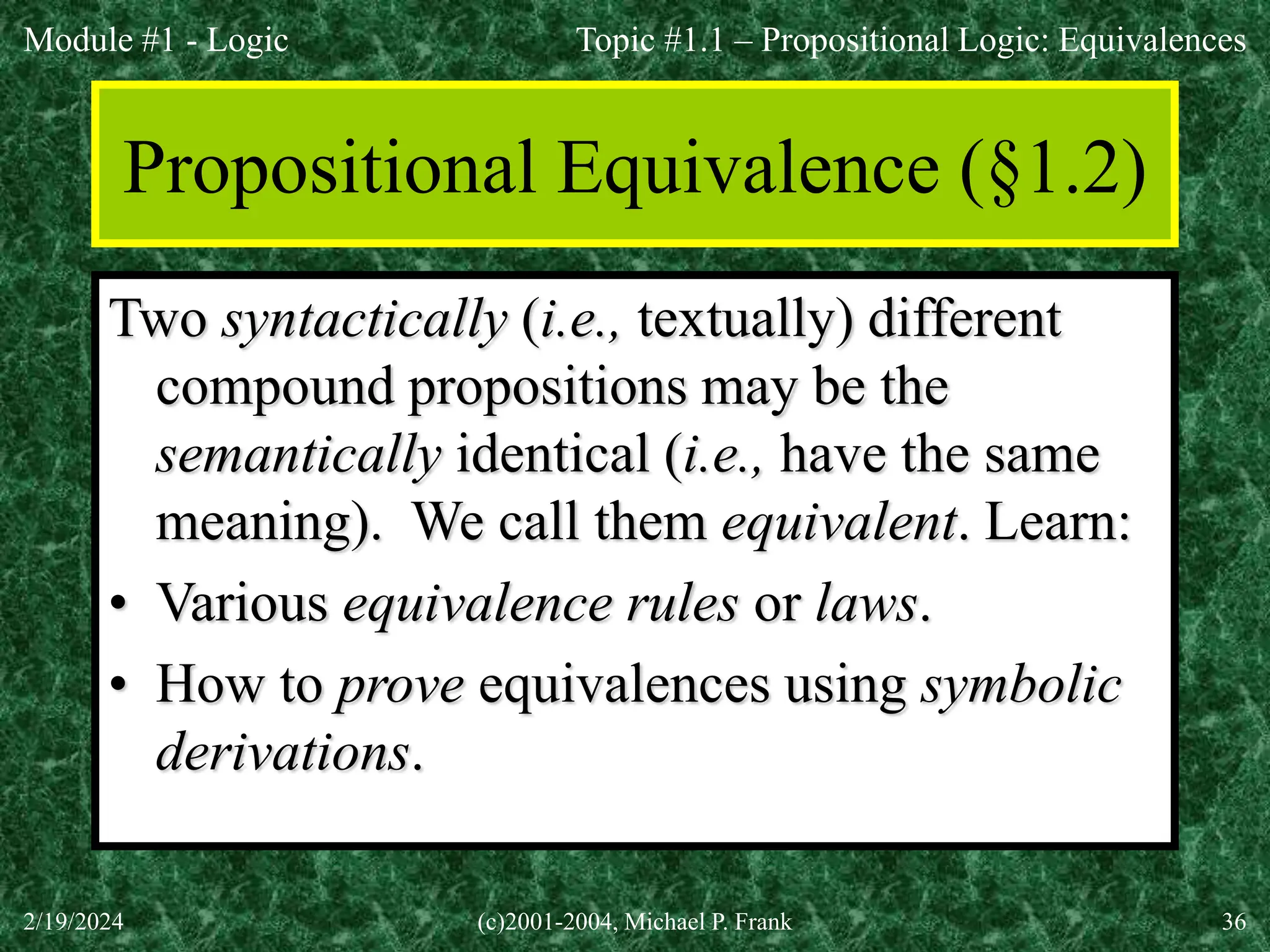
![Module #1 - Logic
2/19/2024 (c)2001-2004, Michael P. Frank 37
Tautologies and Contradictions
A tautology is a compound proposition that is
true no matter what the truth values of its
atomic propositions are!
Ex. p p [What is its truth table?]
A contradiction is a compound proposition
that is false no matter what! Ex. p p
[Truth table?]
Other compound props. are contingencies.
Topic #1.1 – Propositional Logic: Equivalences](https://image.slidesharecdn.com/1-240219125419-9ac39202/75/Logic-mathematics-in-the-modern-world-37-2048.jpg)
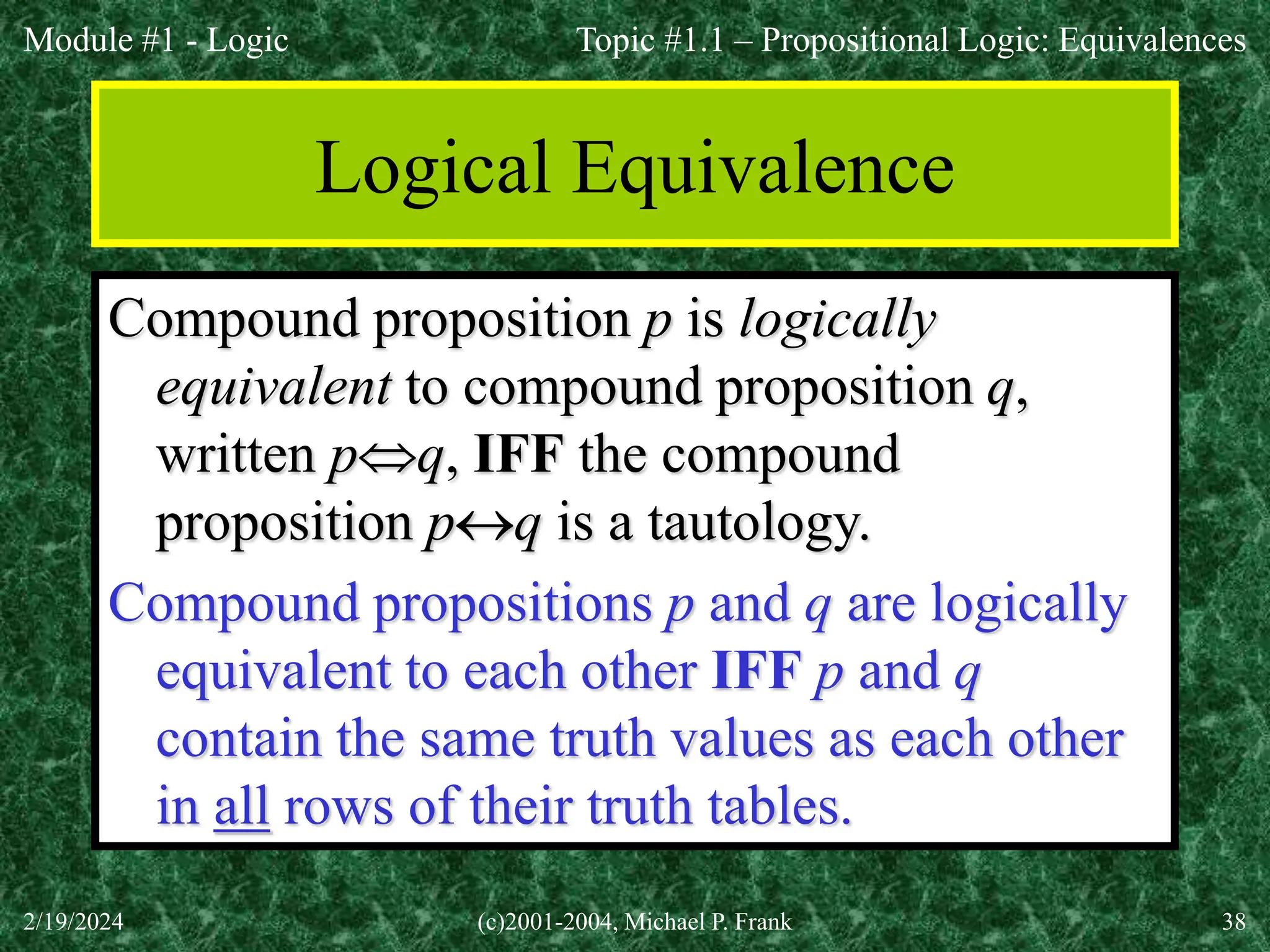

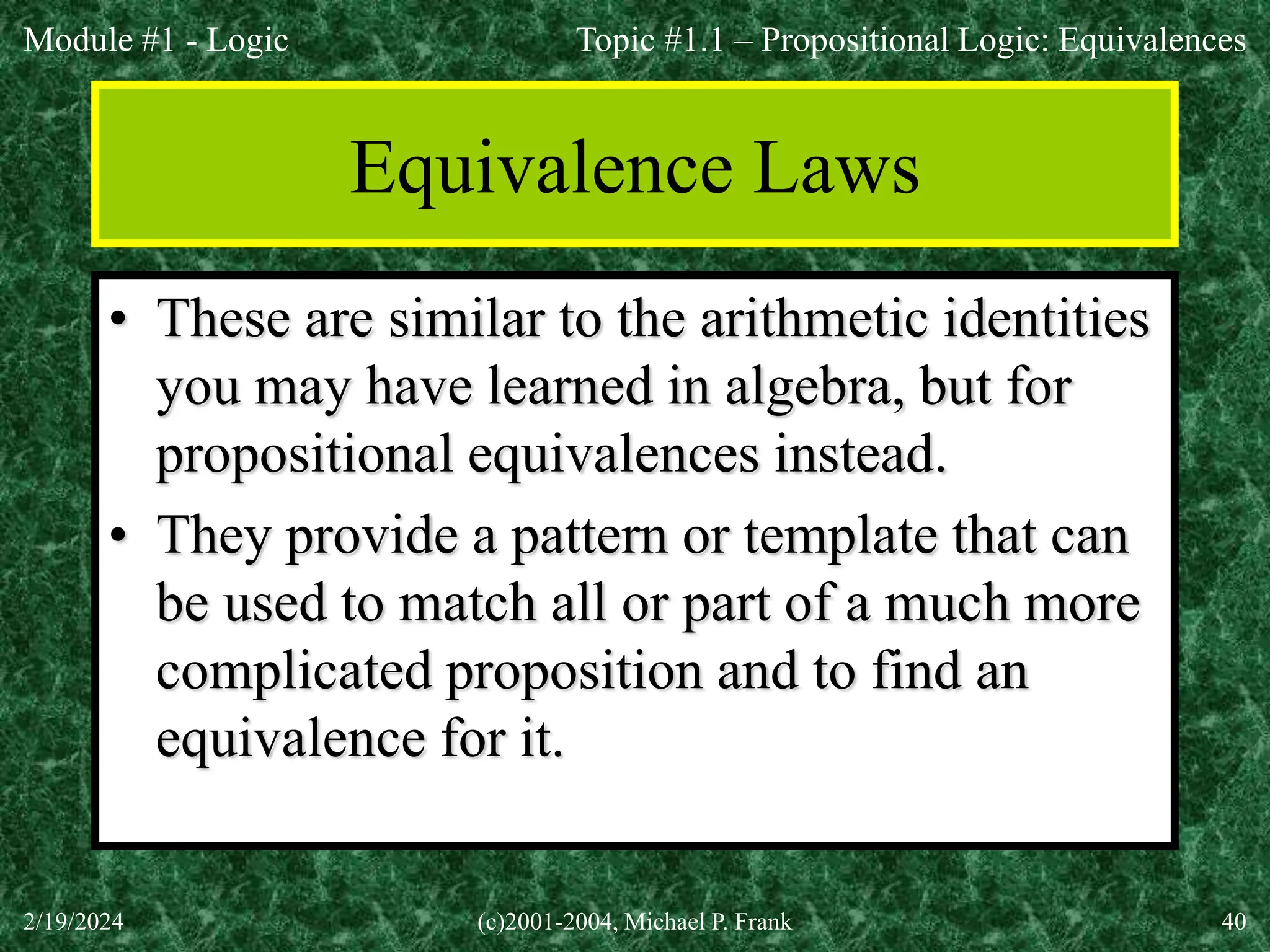



![Module #1 - Logic
2/19/2024 (c)2001-2004, Michael P. Frank 44
An Example Problem
• Check using a symbolic derivation whether
(p q) (p r) p q r.
(p q) (p r) [Expand definition of ]
(p q) (p r) [Expand defn. of ]
(p q) ((p r) (p r))
[DeMorgan’s Law]
(p q) ((p r) (p r))
cont.
Topic #1.1 – Propositional Logic: Equivalences](https://image.slidesharecdn.com/1-240219125419-9ac39202/75/Logic-mathematics-in-the-modern-world-44-2048.jpg)
![Module #1 - Logic
2/19/2024 (c)2001-2004, Michael P. Frank 45
Example Continued...
(p q) ((p r) (p r)) [ commutes]
(q p) ((p r) (p r)) [ associative]
q (p ((p r) (p r))) [distrib. over ]
q (((p (p r)) (p (p r)))
[assoc.] q (((p p) r) (p (p r)))
[trivail taut.] q ((T r) (p (p r)))
[domination] q (T (p (p r)))
[identity] q (p (p r)) cont.
Topic #1.1 – Propositional Logic: Equivalences](https://image.slidesharecdn.com/1-240219125419-9ac39202/75/Logic-mathematics-in-the-modern-world-45-2048.jpg)
![Module #1 - Logic
2/19/2024 (c)2001-2004, Michael P. Frank 46
End of Long Example
q (p (p r))
[DeMorgan’s] q (p (p r))
[Assoc.] q ((p p) r)
[Idempotent] q (p r)
[Assoc.] (q p) r
[Commut.] p q r
Q.E.D. (quod erat demonstrandum)
Topic #1.1 – Propositional Logic: Equivalences
(Which was to be shown.)](https://image.slidesharecdn.com/1-240219125419-9ac39202/75/Logic-mathematics-in-the-modern-world-46-2048.jpg)

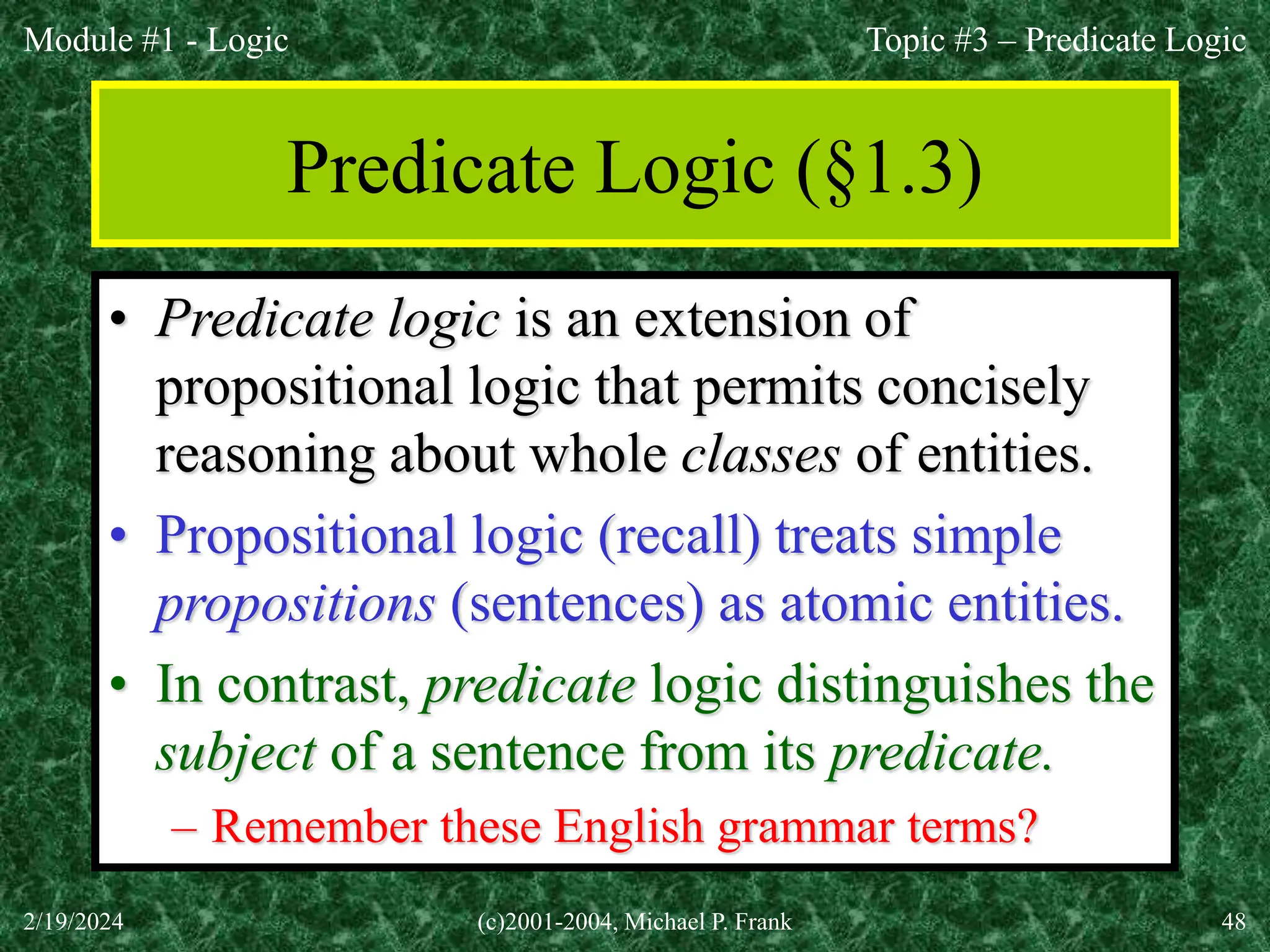




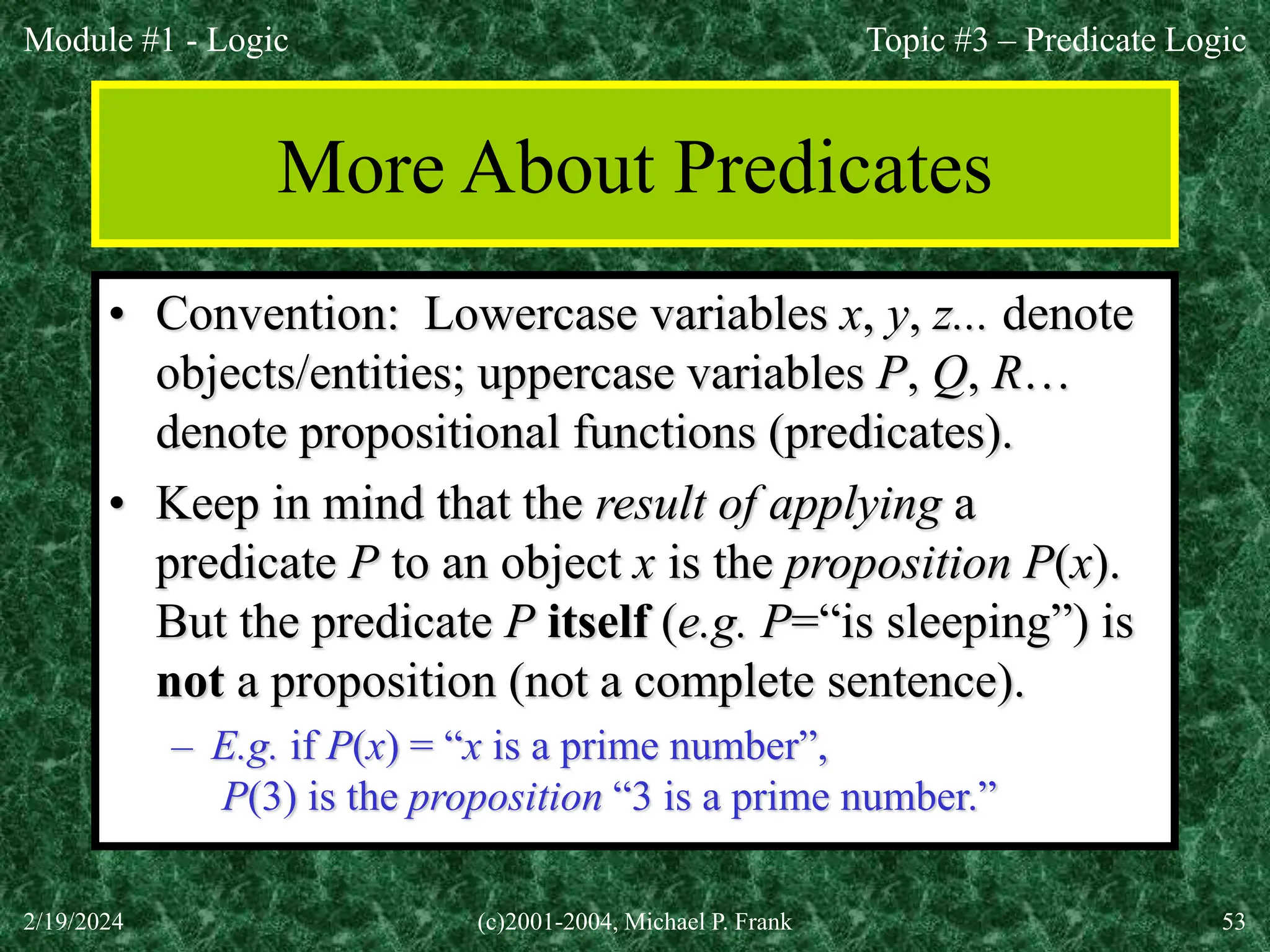



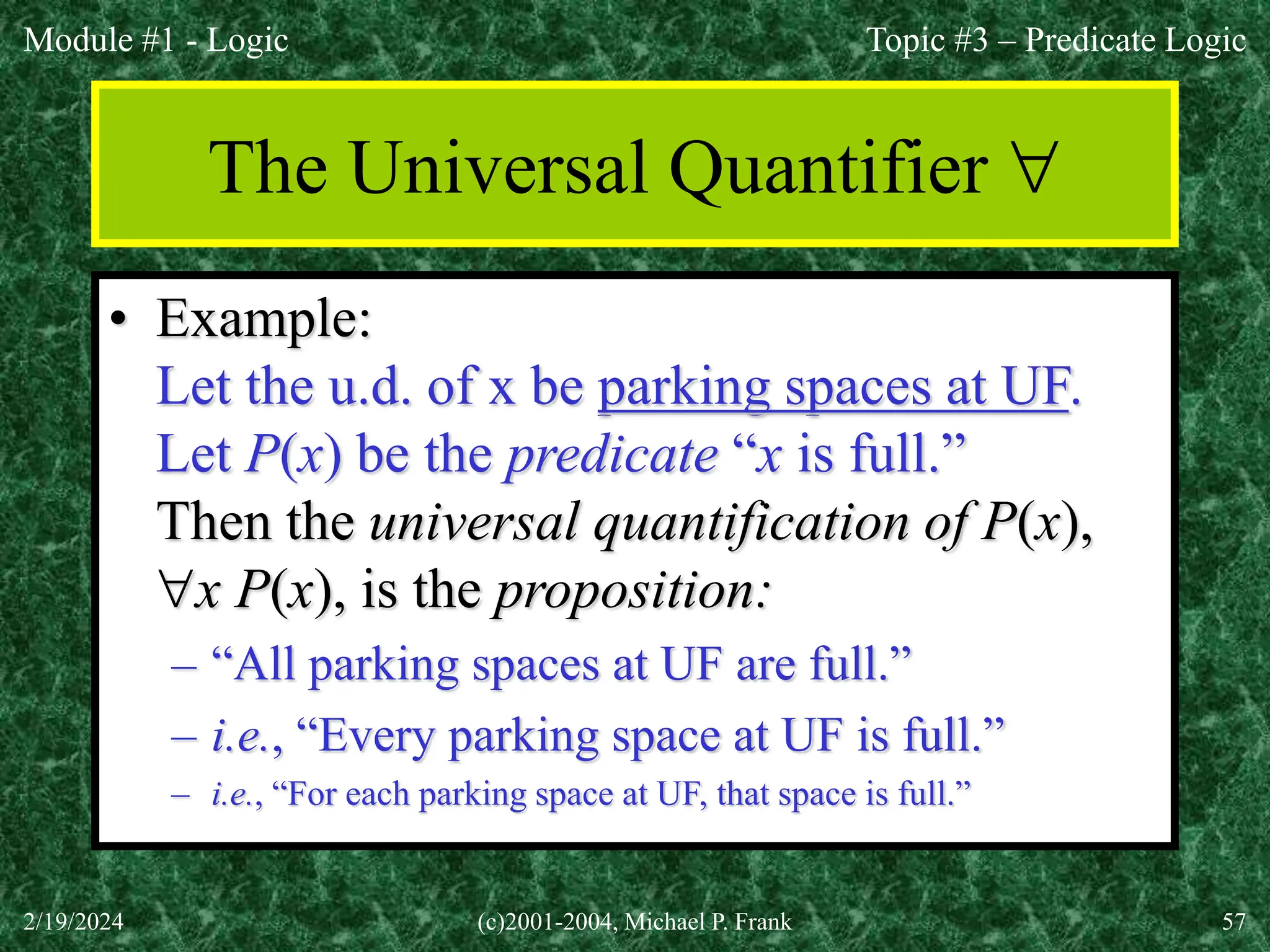

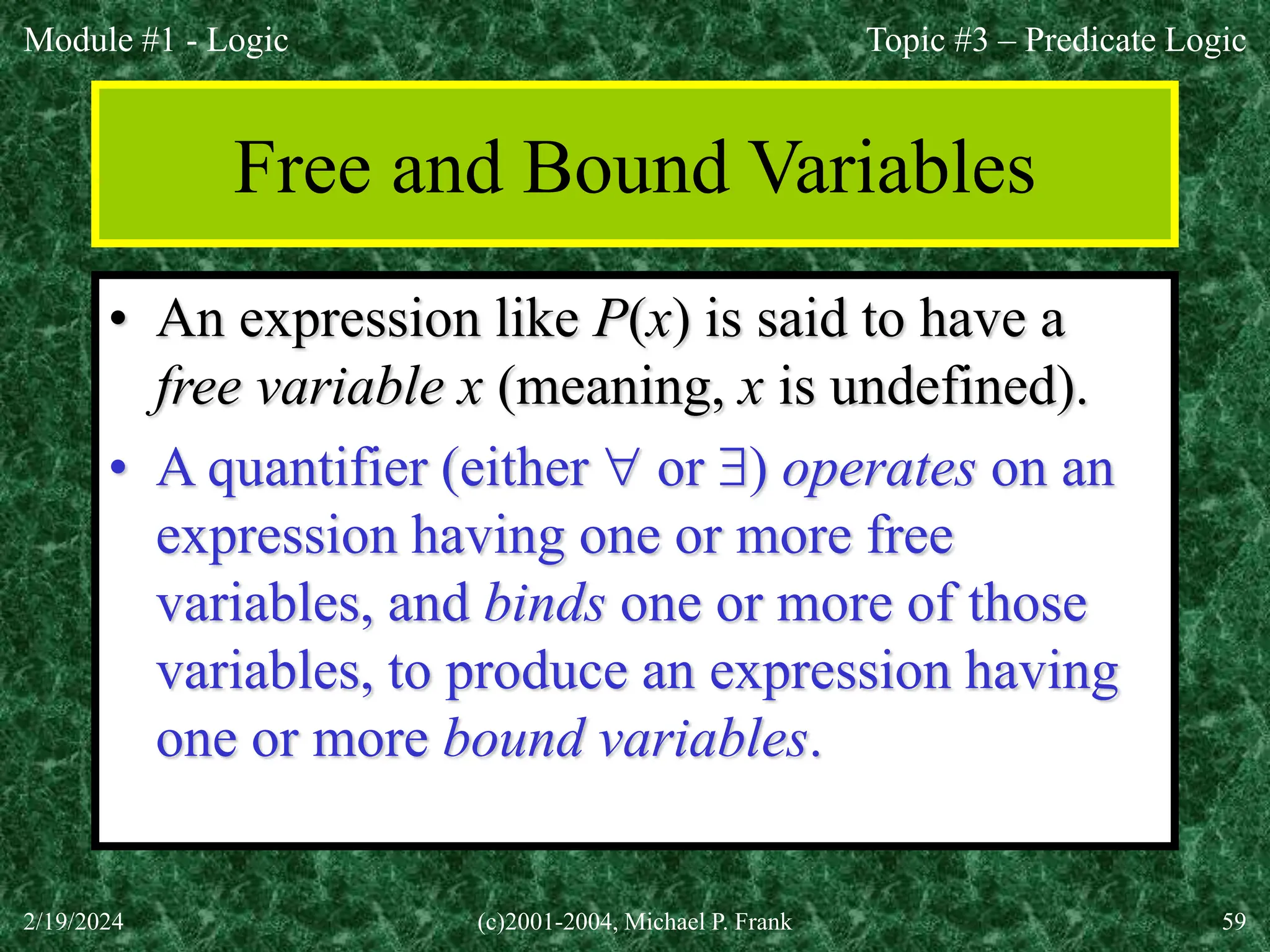
![Module #1 - Logic
2/19/2024 (c)2001-2004, Michael P. Frank 60
Example of Binding
• P(x,y) has 2 free variables, x and y.
• x P(x,y) has 1 free variable, and one bound
variable. [Which is which?]
• “P(x), where x=3” is another way to bind x.
• An expression with zero free variables is a bona-
fide (actual) proposition.
• An expression with one or more free variables is
still only a predicate: e.g. let Q(y) = x P(x,y)
Topic #3 – Predicate Logic](https://image.slidesharecdn.com/1-240219125419-9ac39202/75/Logic-mathematics-in-the-modern-world-60-2048.jpg)

![Module #1 - Logic
2/19/2024 (c)2001-2004, Michael P. Frank 62
Review: Predicate Logic (§1.3)
• Objects x, y, z, …
• Predicates P, Q, R, … are functions
mapping objects x to propositions P(x).
• Multi-argument predicates P(x, y).
• Quantifiers: [x P(x)] :≡ “For all x’s, P(x).”
[x P(x)] :≡ “There is an x such that P(x).”
• Universes of discourse, bound & free vars.](https://image.slidesharecdn.com/1-240219125419-9ac39202/75/Logic-mathematics-in-the-modern-world-62-2048.jpg)
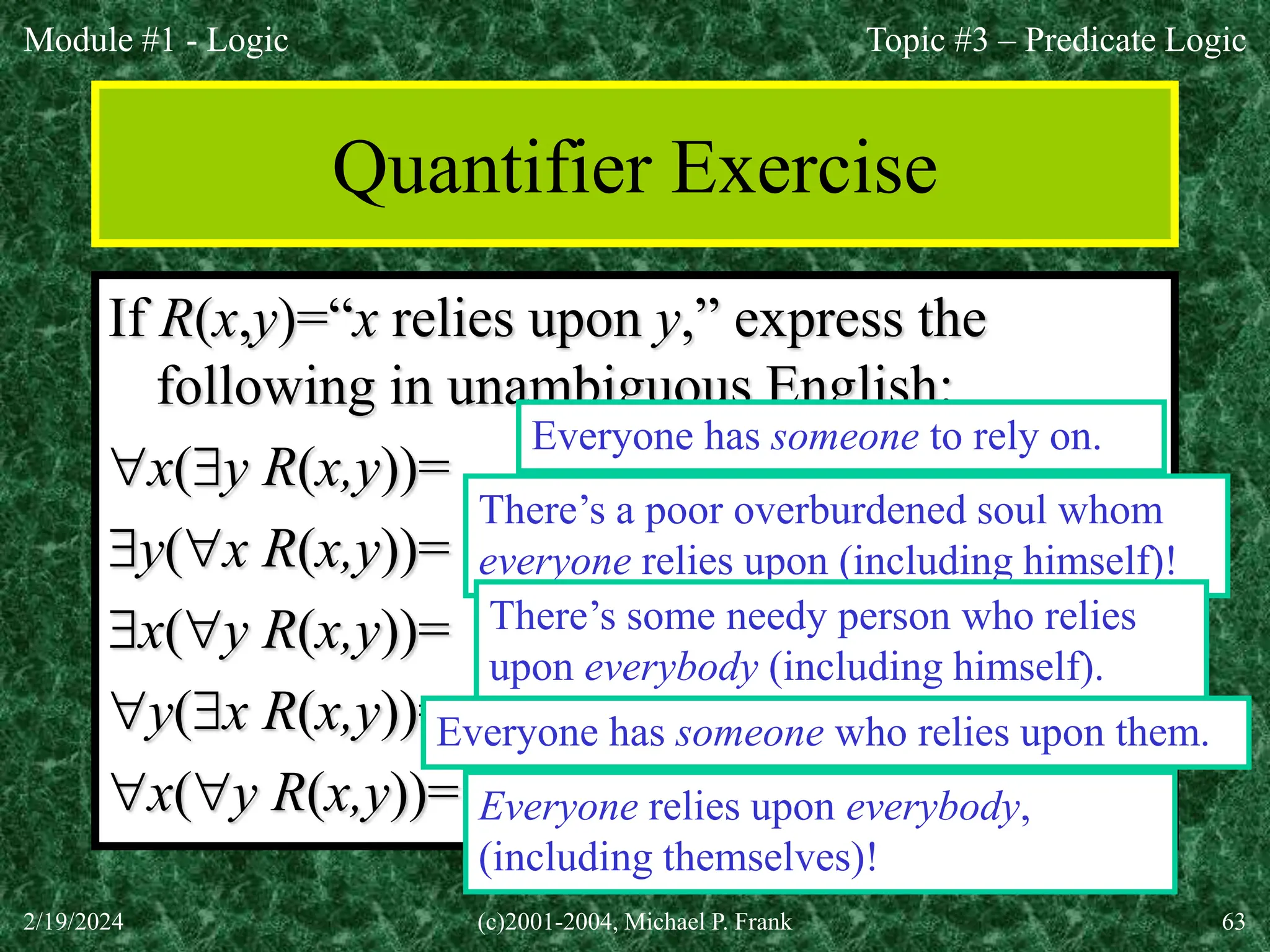
![Module #1 - Logic
2/19/2024 (c)2001-2004, Michael P. Frank 64
Natural language is ambiguous!
• “Everybody likes somebody.”
– For everybody, there is somebody they like,
• x y Likes(x,y)
– or, there is somebody (a popular person) whom
everyone likes?
• y x Likes(x,y)
• “Somebody likes everybody.”
– Same problem: Depends on context, emphasis.
[Probably more likely.]
Topic #3 – Predicate Logic](https://image.slidesharecdn.com/1-240219125419-9ac39202/75/Logic-mathematics-in-the-modern-world-64-2048.jpg)
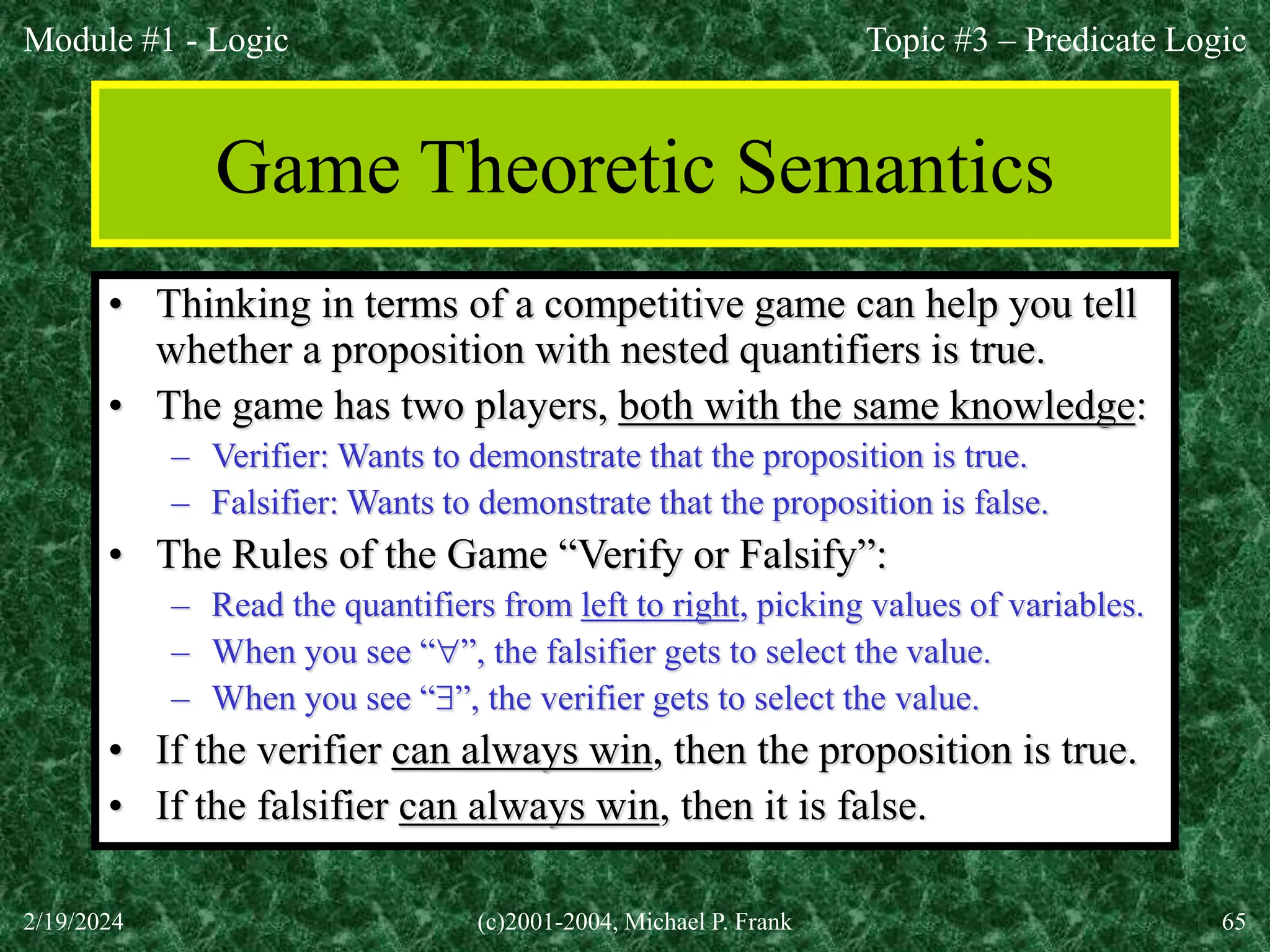
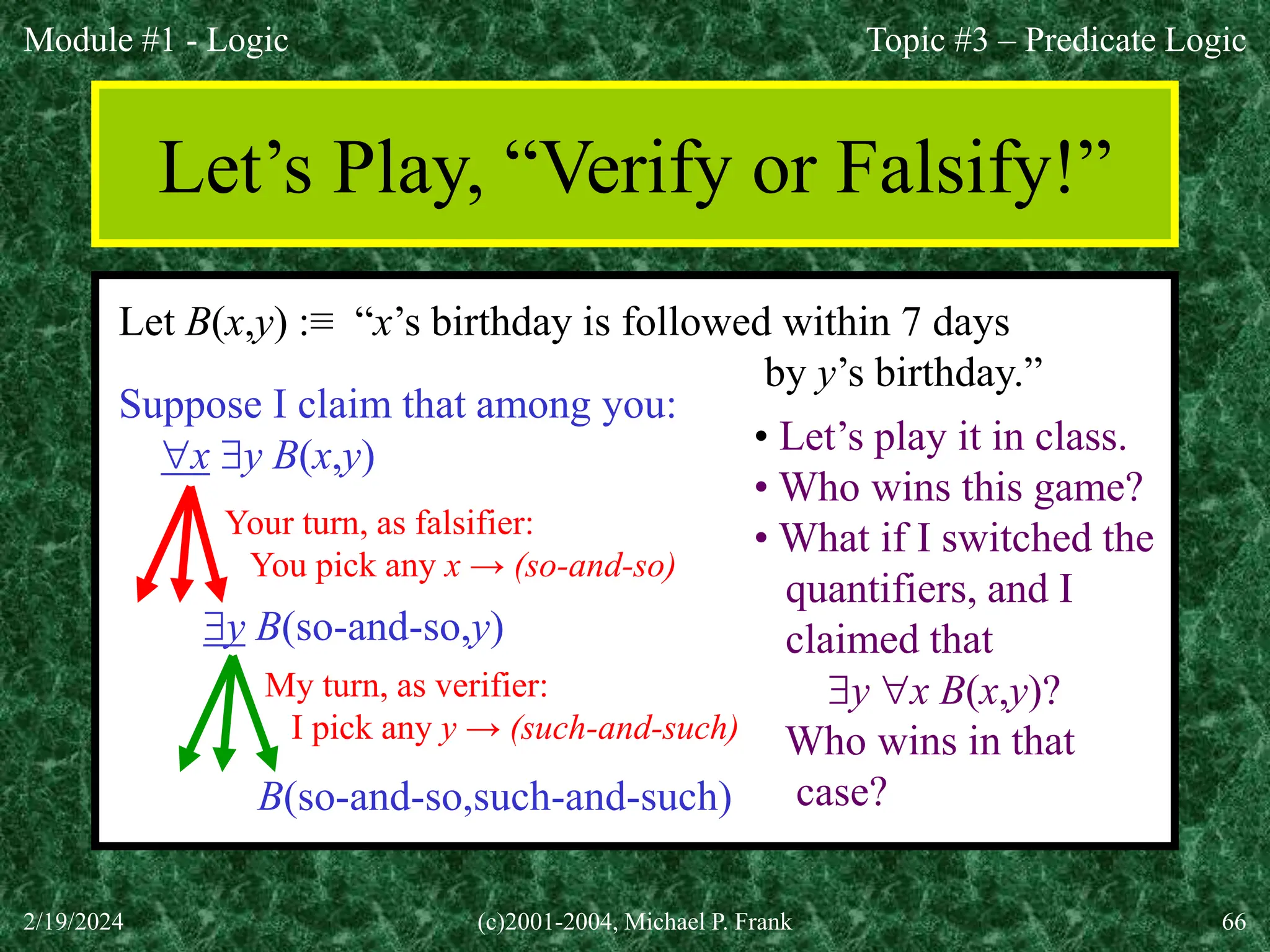
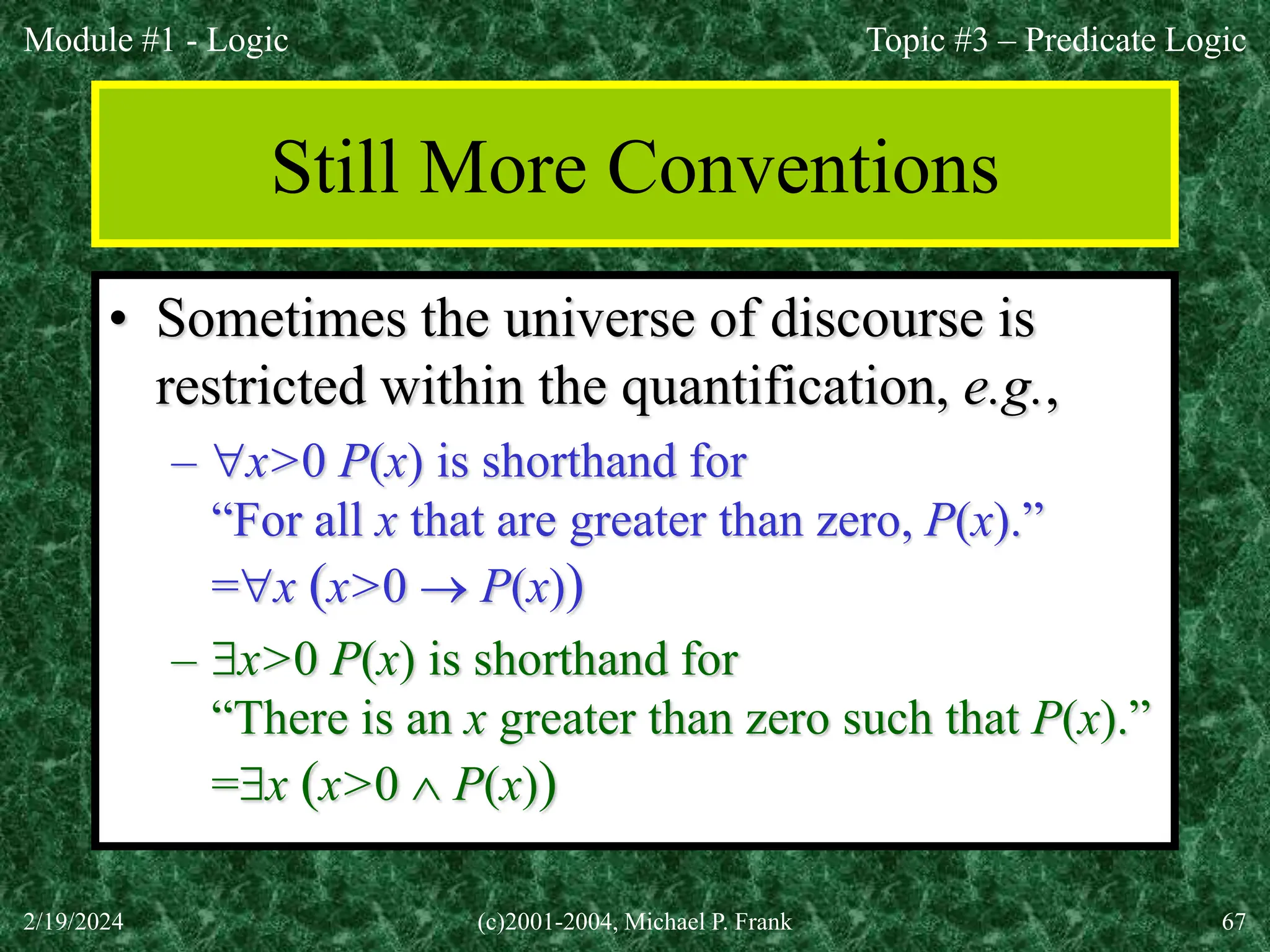



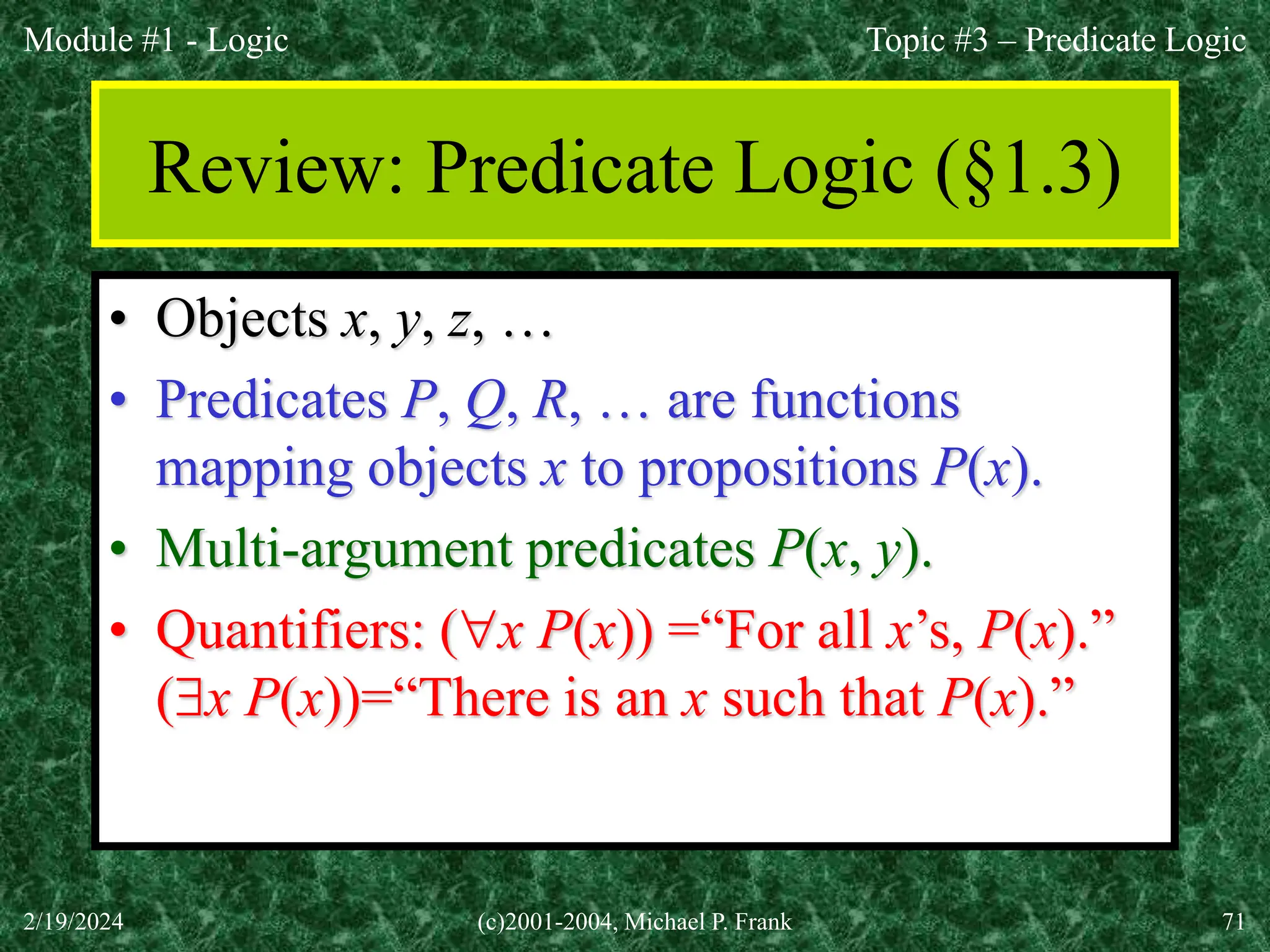
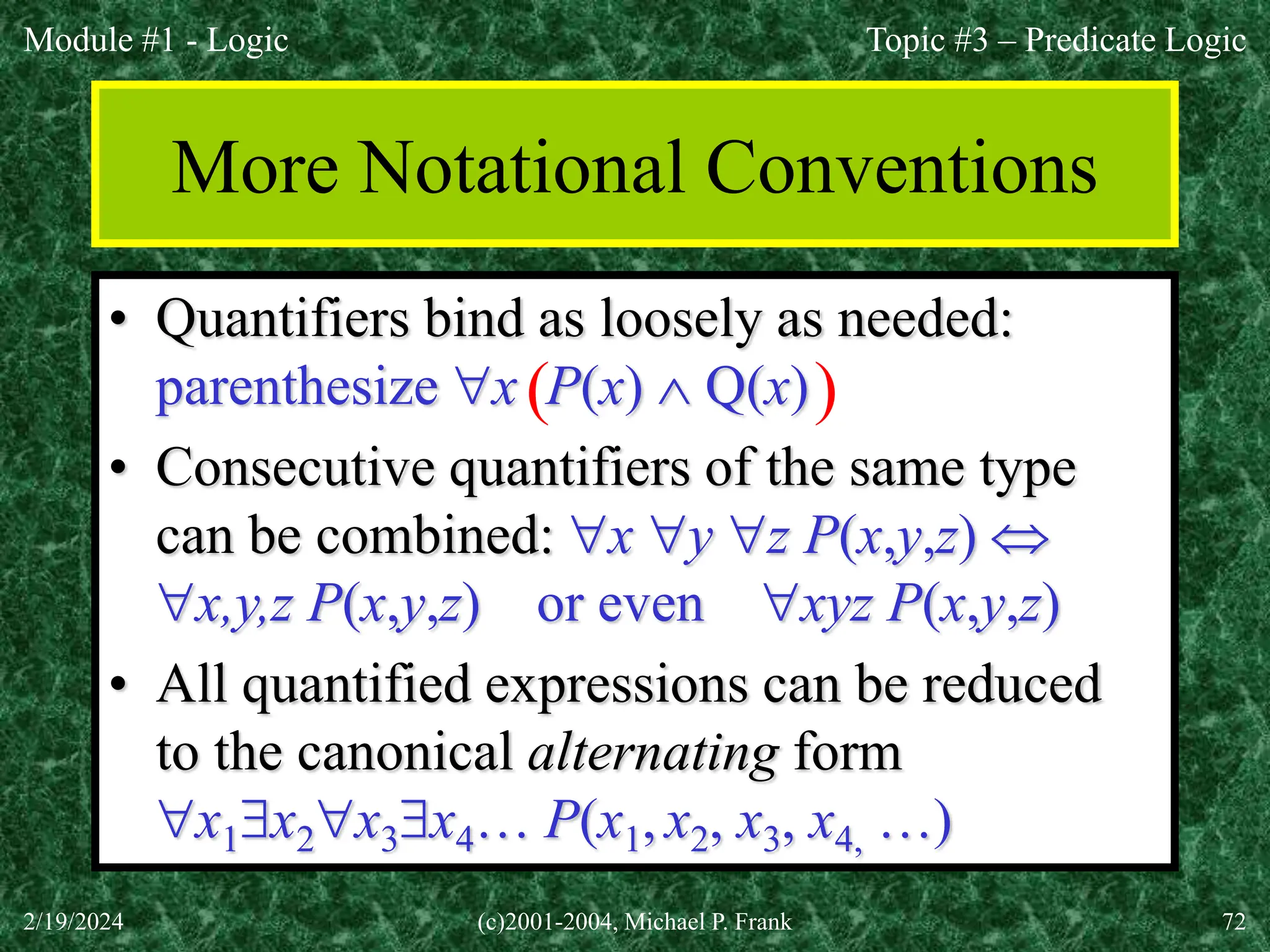

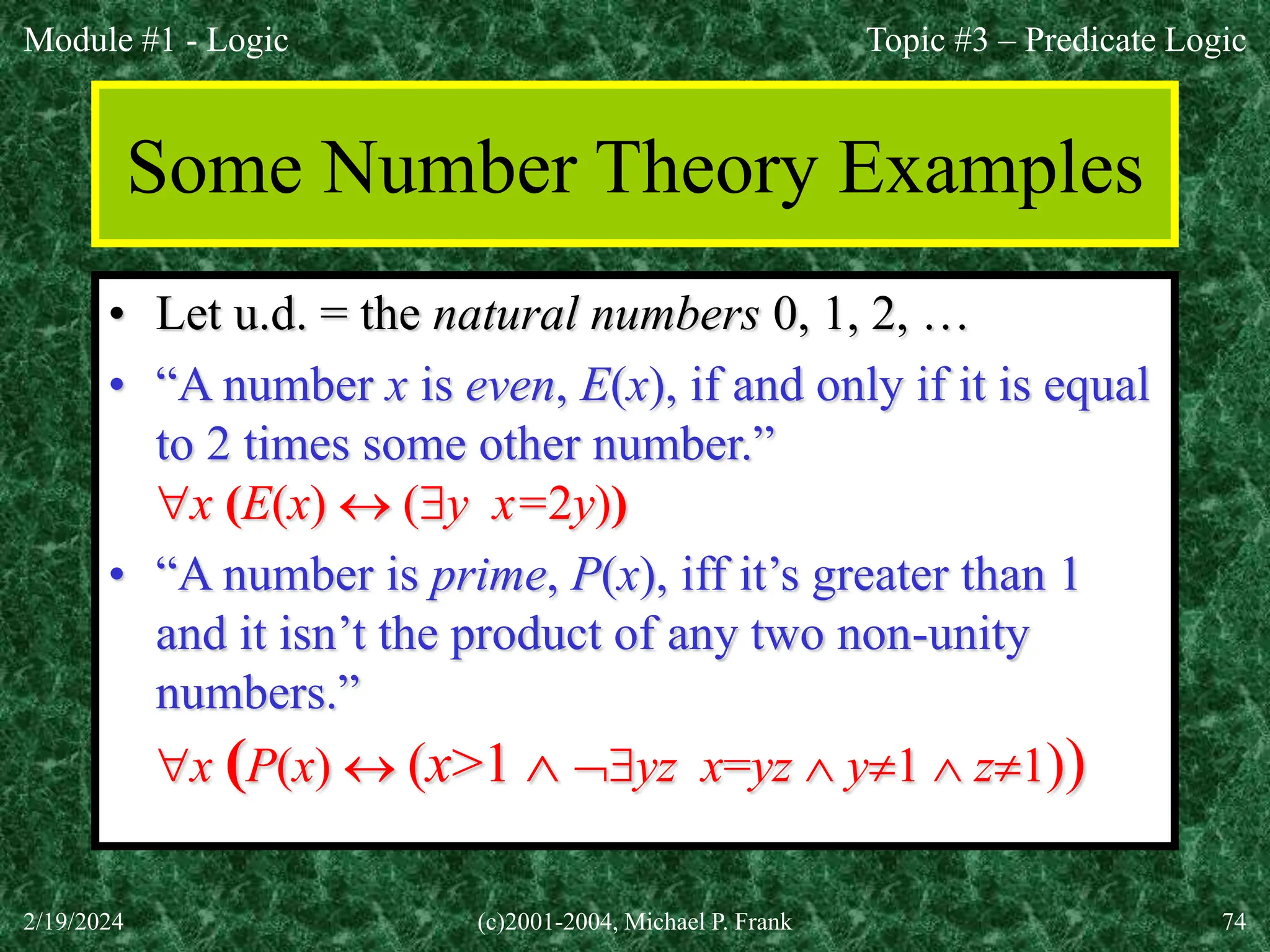
![Module #1 - Logic
2/19/2024 (c)2001-2004, Michael P. Frank 75
Goldbach’s Conjecture (unproven)
Using E(x) and P(x) from previous slide,
E(x>2): P(p),P(q): p+q = x
or, with more explicit notation:
x [x>2 E(x)] →
p q P(p) P(q) p+q = x.
“Every even number greater than 2
is the sum of two primes.”
Topic #3 – Predicate Logic](https://image.slidesharecdn.com/1-240219125419-9ac39202/75/Logic-mathematics-in-the-modern-world-75-2048.jpg)
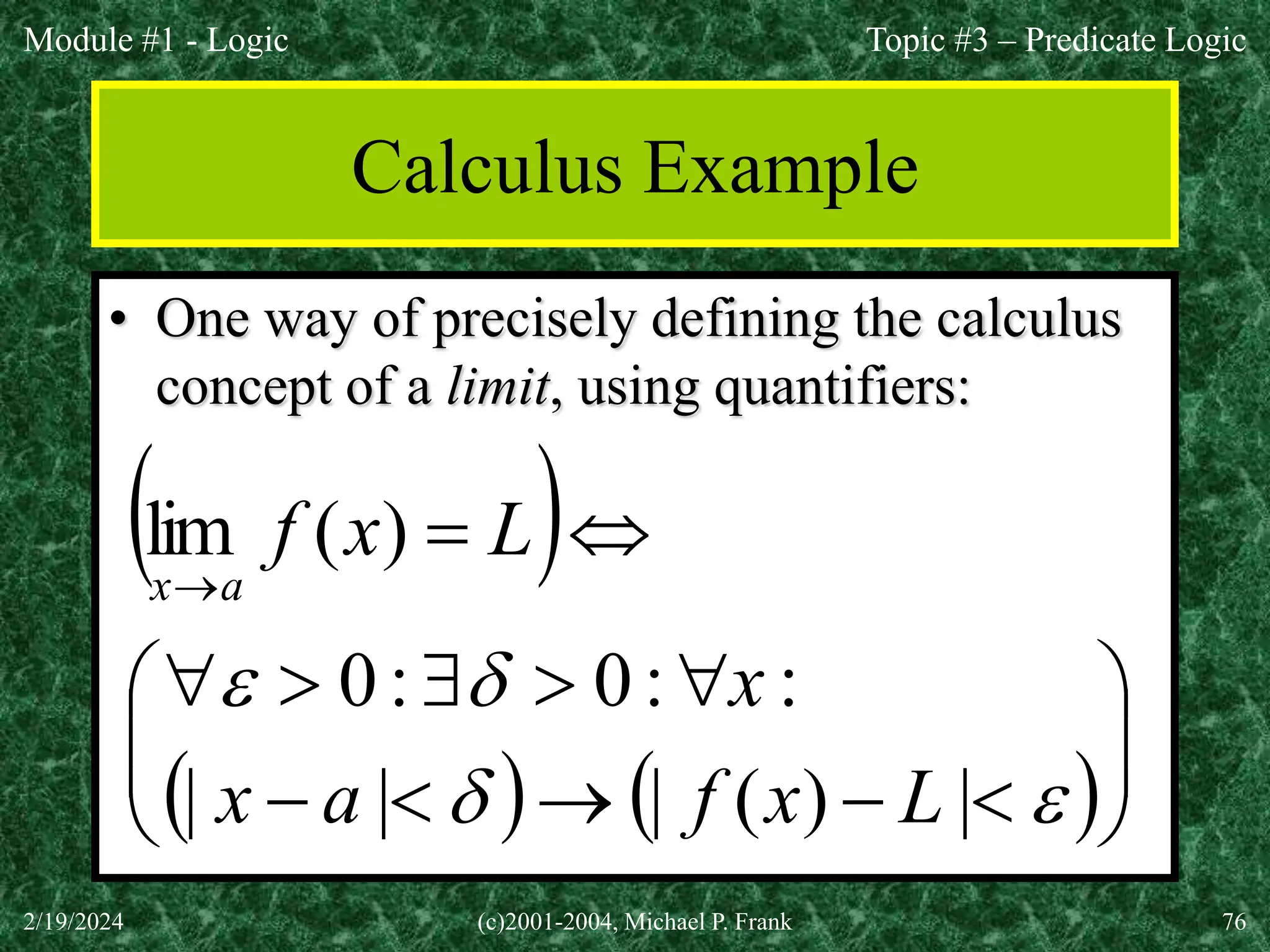

![Module #1 - Logic
2/19/2024 (c)2001-2004, Michael P. Frank 78
Deduction Example Continued
Some valid conclusions you can draw:
H(s)M(s) [Instantiate universal.] If Socrates is human
then he is mortal.
H(s) M(s) Socrates is inhuman or mortal.
H(s) (H(s) M(s))
Socrates is human, and also either inhuman or mortal.
(H(s) H(s)) (H(s) M(s)) [Apply distributive law.]
F (H(s) M(s)) [Trivial contradiction.]
H(s) M(s) [Use identity law.]
M(s) Socrates is mortal.
Topic #3 – Predicate Logic](https://image.slidesharecdn.com/1-240219125419-9ac39202/75/Logic-mathematics-in-the-modern-world-78-2048.jpg)

![Module #1 - Logic
2/19/2024 (c)2001-2004, Michael P. Frank 80
The Derivation
• x H(x)M(x) and x G(x)M(x).
• x M(x)H(x) [Contrapositive.]
• x [G(x)M(x)] [M(x)H(x)]
• x G(x)H(x) [Transitivity of .]
• x G(x) H(x) [Definition of .]
• x (G(x) H(x)) [DeMorgan’s law.]
• x G(x) H(x) [An equivalence law.]
Topic #3 – Predicate Logic](https://image.slidesharecdn.com/1-240219125419-9ac39202/75/Logic-mathematics-in-the-modern-world-80-2048.jpg)

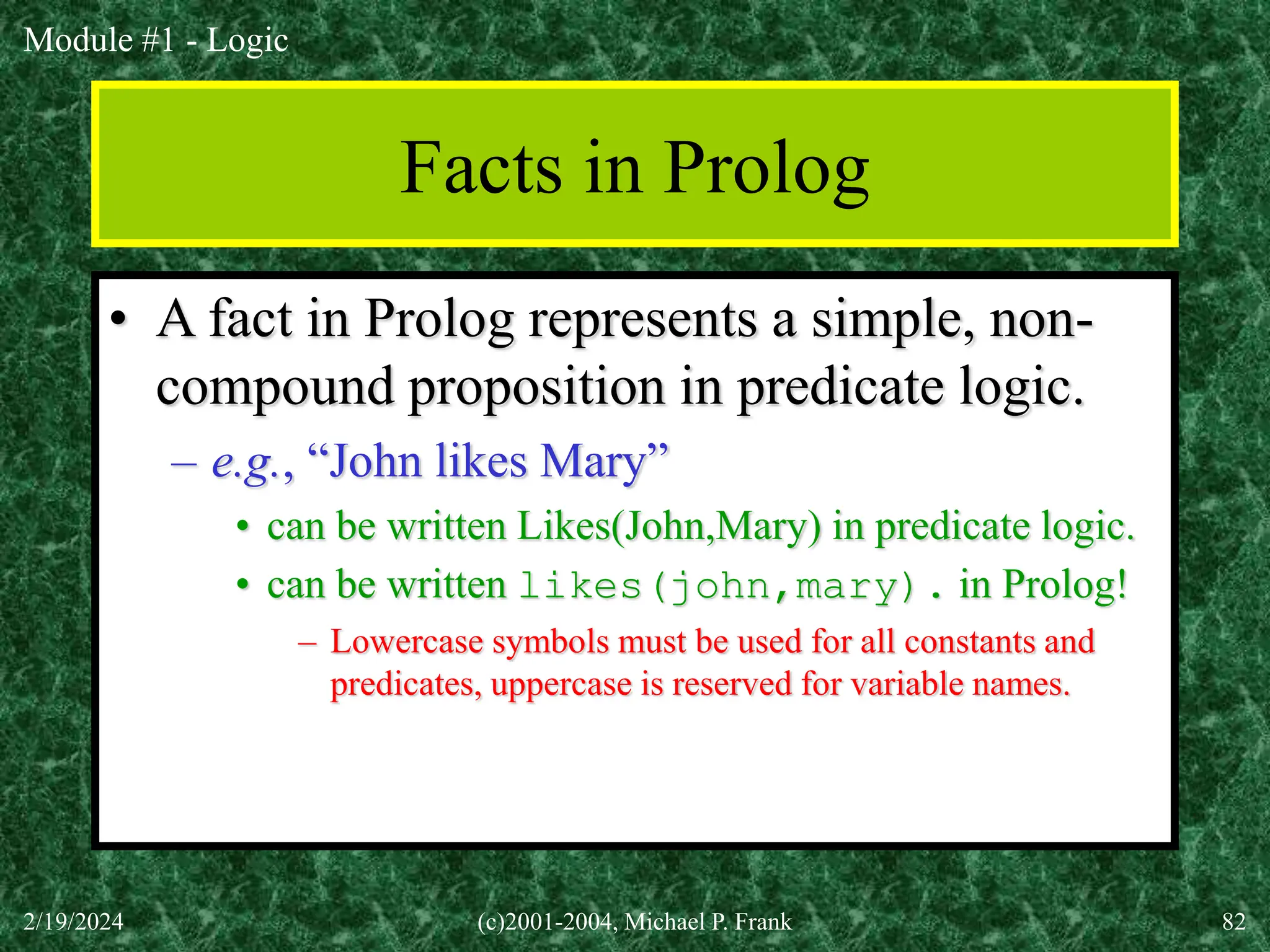
![Module #1 - Logic
2/19/2024 (c)2001-2004, Michael P. Frank 83
Rules in Prolog
• A rule in Prolog represents a universally
quanitifed proposition of the general form
x: [y P(x,y)]→Q(x),
where x and y might be compound variables
x=(z,w) and P,Q compound propositions.
• In Prolog, this is written as the rule:
q(X) :- p(X,Y).
i.e., the , quantifiers are implicit.
• Example: likable(X) :- likes(Y,X).
← Variables must be capitalized](https://image.slidesharecdn.com/1-240219125419-9ac39202/75/Logic-mathematics-in-the-modern-world-83-2048.jpg)
![Module #1 - Logic
2/19/2024 (c)2001-2004, Michael P. Frank 84
Conjunction and Disjunction
• Logical conjunction is encoded using
multiple comma-separated terms in a rule.
• Logical disjunction is encoded using
multiple rules.
• E.g., x [(P(x)Q(x))R(x)]→S(x)
can be rendered in Prolog as:
s(X) :- p(X),q(X)
s(X) :- r(X)](https://image.slidesharecdn.com/1-240219125419-9ac39202/75/Logic-mathematics-in-the-modern-world-84-2048.jpg)
